|
July 11, 2020 - No. 25
Federal
Government's Economic and Fiscal "Snapshot"
Exaltation
of Corruption and Fraud
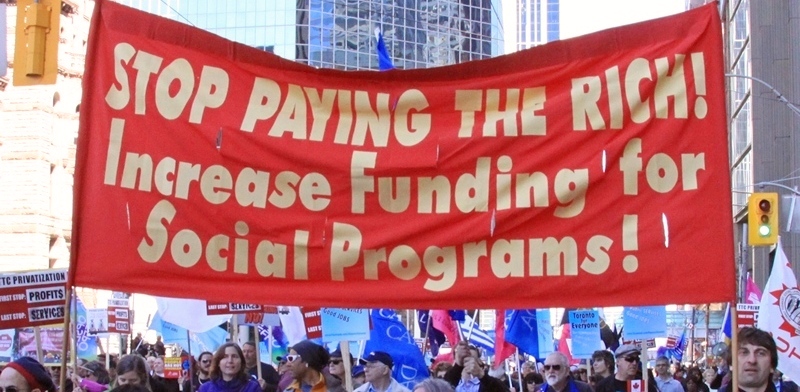
• Let Us Move On to Public Enterprise and
End the Charade
of Private Enterprise and a Free Market
- K.C. Adams -
For Your Information
•
Public Debts
to Global Private Interests
• The Circle of Government Borrowing from
the
Rich to Payouts to the Rich
• Public
Spending Connected with the Pandemic
• Economic
Crisis Causes Suffering to Canadian
Working People and Small Businesses
• Sources of Federal Government Borrowings
• Federal
Government Approval for Public Spending
Cross Canada Day of
Action Demands Status for All!
• The Injustice, Discrimination, and
Super-Exploitation
of Non-Status People Must Stop!
7th Anniversary of
Lac-Mégantic Tragedy
• The Need to Build a Public Authority
that Defends
Public not Private Interests
- Pierre
Chénier -
• Citizen
Action Essential to Ensure Rail Safety
- Interview,
Robert Bellefleur -
30th Anniversary of
the Brutal Military Assault
on the Mohawk at Kanehsatà:ke
• For Nation-to-Nation Relations and an
End to
Genocide of Indigenous Peoples
- Fernand Deschamps -
World-Wide Protests
Condemn the Annexation
of Palestinian Territory
• Peoples of the World Stand as One with
the Palestinian People
Federal Government's
Economic and Fiscal "Snapshot"
The federal government's economic and fiscal
"snapshot" delivered on July 8 provides a good example of
disinformation. In this case the aim is to remain silent about the
substantive issues of where the money which has been borrowed to
weather the pandemic comes from so that Canadians cannot form an
opinion about it which serves them. Far from informing Canadians, the
federal government's economic and fiscal "snapshot" exalts corruption
and fraud; it raises them to an art in the name of high ideals.
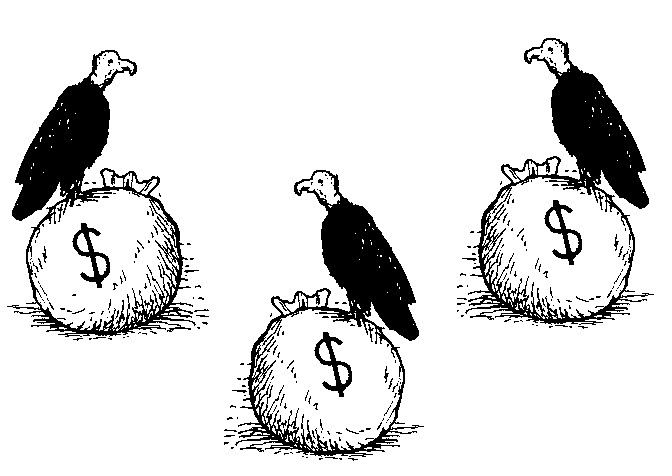 Trudeau set the
stage for this disinformation in a press conference just prior to the
Finance Minister's presentation in Parliament. Referring to what has
now become a $343.2 billion federal deficit to be covered through
government borrowing from the private financial institutions of the
global oligarchy, Trudeau said, "We took on debt so Canadians wouldn't
have to." Clearly the Prime Minister thinks Canadians have no
intelligence; that they cannot see through his unfortunate obsession
with the word "we." Trudeau set the
stage for this disinformation in a press conference just prior to the
Finance Minister's presentation in Parliament. Referring to what has
now become a $343.2 billion federal deficit to be covered through
government borrowing from the private financial institutions of the
global oligarchy, Trudeau said, "We took on debt so Canadians wouldn't
have to." Clearly the Prime Minister thinks Canadians have no
intelligence; that they cannot see through his unfortunate obsession
with the word "we."
The debt the government "we" has taken on is to
the richest and most powerful institutions within the U.S.-led
imperialist system of states. The people "we" will owe this money to
private moneylenders and be forced to pay it back with interest. The
interest rate the people "we" will be paying is also going up as one of
the three major U.S. credit rating agencies, Fitch, recently downgraded
Canada's credit rating from AAA to AA+, making borrowing more expensive.
The "we" who will be responsible for this new debt
of $343.2 billion, driving the federal debt from $765 billion to $1.2
trillion in one year, is essentially Canadian working people. Workers
who produce the value through their work and pay the vast majority of
taxes will be saddled with this debt to the global vultures. The
beneficiaries of this pay-the-rich scheme are the private industrial
and financial global cartels of the imperialists.
The people have had no say in the matter and no
control over what has been done. Convenient and disingenuous indeed to
have we Canadians, we the government and, as Trudeau likes to say, "We
are all in this together."
The fact is: No, we are not in this together. We,
the working people, work and produce value and you the ruling
imperialist oligarchy and your courtiers expropriate the value we
produce; you own and control the economy, and you have usurped the
authority of the state to pay the rich and to defend and sustain your
privilege and private wealth and the great divide between you and us.
You rule and we are excluded from economic and political affairs.
The skyrocketing government deficits and debts to
the rich will unleash even greater attacks on Canadians and a further
deterioration of social programs and public services and an increase in
personal, sales and other individual taxes. The federal, Quebec and
provincial governments, the neo-liberal think tanks and mass media are
preparing an even more intensive round of the anti-social offensive
using the current crisis and "massive debts and deficits" of all levels
of government as the excuse. This has already begun in Alberta with the
anti-worker anti-social attacks of the Jason Kenney United Conservative
Party government against the people, as well as in Quebec, Ontario and
other provinces.
 Governments
declare they have no choice but to borrow from the rich to deal with
the economic crisis. This is disinformation of the highest order. It is
corruption and fraud. As a part of the U.S.-led imperialist system of
states and serving the privilege and private interests of the global
financial oligarchy, the ruling elite in government do not want the
people to see what they do not want them to see -- that government
debts to the global moneylenders are not cast in stone but a deliberate
policy to pay the rich. Governments
declare they have no choice but to borrow from the rich to deal with
the economic crisis. This is disinformation of the highest order. It is
corruption and fraud. As a part of the U.S.-led imperialist system of
states and serving the privilege and private interests of the global
financial oligarchy, the ruling elite in government do not want the
people to see what they do not want them to see -- that government
debts to the global moneylenders are not cast in stone but a deliberate
policy to pay the rich.
Despite the efforts of the Trudeau government and
the opposition cartel parties and media to hide the corruption and
fraud, their exaltation has become obvious to the people who are
working hard and demand a new direction for the economy. The
alternative begins by demanding that governments stop paying the rich
and increase investments in social programs.
The people will have to demand that a moratorium
be declared on servicing existing debt and make illegal public
borrowing from private interests. Instead, governments should borrow
from themselves as a public debt to themselves to be settled without
interest as the economy grows and workers produce greater social
product. Such a new direction would prohibit the global oligarchs from
taking value out of the economy and prohibit all levels of government
from going into debt to private interests.

- K.C. Adams -
A state organized to pay
the rich is not a free market.
It is a market controlled for the privileged few.
The total Canadian federal debt to global private
interests following this year's $343.2 billion deficit will rise to
$1.2 trillion.
Contrary to what Prime Minister Trudeau alleges,
Canadians will suffer from this debt to the rich as repayment with
interest will come out of the value workers produce at work, from
reduced social programs and public services and a deteriorating
standard of living.
 The U.S.-led
imperialist system of states has been organized to pay the rich. It
does everything to defend and sustain the privilege of ownership of
private enterprise and the stupendously wealthy oligarchs who own and
control the private global industrial and financial cartels. The U.S.-led
imperialist system of states has been organized to pay the rich. It
does everything to defend and sustain the privilege of ownership of
private enterprise and the stupendously wealthy oligarchs who own and
control the private global industrial and financial cartels.
The private enterprises that benefit from what
workers produce and from state pay-the-rich schemes are the material
basis of inequality and exploitation of people and the economy, and the
cause of the recurring economic crises that wreak havoc with people's
lives. Yet still, songs are sung and speeches ring out that private
enterprise represents the free market and the highest form of human
economic organization. Nonsense. A state organized to pay the rich is
not a free market. It is a market controlled for the privileged few.
Workers ask, what is free about the free market
when private enterprises lend money to governments and receive it back
with interest and in grants, subsidies, guaranteed contracts and other
pay-the-rich schemes? That is not the free market. That is the rich
conning the world with its tired old myths of the free market and
private enterprise being the greatest.
Private enterprise loves the social wealth it
expropriates from its own workers and from others through government
handouts. It loves lending its excess private wealth to governments and
then receiving it back both with interest and in pay-the-rich schemes
of subsidies, grants and guaranteed government contracts. It loves the
state saving it from disaster during one of its recurring economic
crises. This is not the free market; this is a ruling oligarchy
exploiting the working people and using the power of the state to
defend its private interests and privilege.
Enough of this odious free market nonsense. The
industrial and financial cartels overwhelmed the free market in the
early years of the twentieth century. If the private cartels cannot
make it in the economy without public handouts, which obviously they
cannot, then the working people should brush them aside and move on to
the New. The working people demand public enterprise and governments
under their control and organized to serve the public interest not
certain privileged private interests.

For
Your Information
Federal government debt
to reach $1.2 trillion
 Working people
should ponder a situation where such great amounts of
privately-controlled money are so readily available for governments to
borrow. How can the rich oligarchs be in possession of such enormous
wealth at a time of crisis when governments declare themselves broke?
The stupendous amount the rich have available to lend to governments
indicates how productive the working class is and how much the rich
expropriate and accumulate from what workers produce. The billions the
government will borrow from private sources to cover the $343 billion
deficit originate from the work-time of the Canadian working class but
end up under the control of a minority of immensely wealthy global
oligarchs. Working people
should ponder a situation where such great amounts of
privately-controlled money are so readily available for governments to
borrow. How can the rich oligarchs be in possession of such enormous
wealth at a time of crisis when governments declare themselves broke?
The stupendous amount the rich have available to lend to governments
indicates how productive the working class is and how much the rich
expropriate and accumulate from what workers produce. The billions the
government will borrow from private sources to cover the $343 billion
deficit originate from the work-time of the Canadian working class but
end up under the control of a minority of immensely wealthy global
oligarchs.
Think about it. How is it that these rich
oligarchs have such vast fortunes to buy government securities? Where
does it come from to end up in the hands of a few? The working people
engaged on socialized means of production produce the wealth seized by
the few. This must change if the world is to be set right. A new
direction for the economy must come into being where those who do the
work and produce the value control the economy and the social product
they produce.
The government spends much of the money it borrows
and gains from taxes to prop up and support private enterprise, in
particular the biggest and most powerful enterprises, sometimes deemed
too big to fail and sometimes systemically important. Working people
demand to know why public funds should go to sustain private enterprise
and the control of the economy and lavish lifestyles of the rich.
Money Comes Back to the Rich in Spades
 The captains of
industry, finance and commerce are not simply waiting for their
purchase of government bonds to be repaid with interest. They are
eagerly anticipating that the money they have loaned to governments
will soon come back to them in lucrative pay-the-rich schemes. The
government has already announced billions of dollars of guaranteed
infrastructure projects: contracts for military supplies to prepare for
war are a constant feature, and supplying the education and health care
sectors with computers, and pharmaceuticals such as a vaccine for
COVID-19 means guaranteed profits for the biggest companies. The captains of
industry, finance and commerce are not simply waiting for their
purchase of government bonds to be repaid with interest. They are
eagerly anticipating that the money they have loaned to governments
will soon come back to them in lucrative pay-the-rich schemes. The
government has already announced billions of dollars of guaranteed
infrastructure projects: contracts for military supplies to prepare for
war are a constant feature, and supplying the education and health care
sectors with computers, and pharmaceuticals such as a vaccine for
COVID-19 means guaranteed profits for the biggest companies.
The imperialist economic system is a circular
single whole that guarantees the rich will become richer and the poor
poorer as wealth and power are increasingly concentrated in fewer
hands. Only the working class can breach the vicious cycle and forge a
new direction that favours the people and averts the recurring economic
crises.

The imperialist oligarchy regards lending to
governments and then profiting from government projects and payouts as
a way to skin the ox many times. The government borrows money from
private interests to finance its deficits. As it borrows from the rich
oligarchs, the government simultaneously announces pay-the-rich schemes
through public/private/partnerships to build infrastructure and other
projects. Much of the activity in the service sector is arranged
through government contracts to global cartels, including food and
laundry services in hospitals and prisons, military supply contracts
and extremely lucrative contracts for pharmaceuticals.
The imperialists' "virtuous circle" was summed up
in a recent item in TML
Weekly:
1. The Bank of Canada begins the process with the
purchase of securities held by the global financial oligarchy. Some of
the corporate bonds contain mortgages and other loans owned by the
private financial institutions and biggest corporations. Many of the
mortgages and loans contained within the bonds are now coming under
stress from the economic crisis and may collapse. The Bank of Canada
has said the amount it may purchase could reach $150 billion and will
include the purchase of bonds held by provincial and other levels of
government. In addition, the public Canada Mortgage and Housing
Corporation (CMHC) has announced the purchase of $50 billion worth of
mortgages held currently by the big banks. The rationale behind all
this public money pouring into the coffers of global oligarchs is that
the private moneylenders will now invest in the troubled economy but in
fact those same global financial institutions are simply saving their
own troubled investments and using some of the money to buy guaranteed
government securities.
2. The financial oligarchy takes the public money
from the Bank of Canada and CMHC from the purchase of its securities
and buys the now even more plentiful government bonds, as the federal
and other government deficits have soared. These purchases become a
safe haven for the social wealth of the oligarchs during the crisis
where other investment opportunities have dried up or have become too
risky. The guaranteed government bonds even pay interest.
3. The government takes the private money it
borrows from the financial oligarchy through the sale of its securities
and puts a portion of the money towards financing infrastructure
projects. This becomes the seed money to begin construction.
4. The government enlists the private global
construction cartels to build the infrastructure projects. Those
companies do not have to raise the financing themselves or worry about
selling the finished project. The government gives them the
construction money as the projects proceed, which includes a healthy
profit. This activity is all guaranteed by the government, including
exorbitant prices the private construction cartels charge to complete
the projects.
5. Once built, the main users of the public means
of production (the roads, bridges, electricity etc), which are the big
private enterprises in the economy, do not have to pay the full market
price for the value of the portion of the infrastructure they consume,
as they are given preferential concocted "industrial" rates.
 This virtuous
circle of the imperialists explains how the federal government's
infrastructure plan called "Investing in Canada" pays the rich and
contributes to the ever greater concentration of wealth and power in
fewer hands. The federal government in 2019 committed $187 billion in
infrastructure funding over 12 years. The C.D. Howe Institute, an
imperialist think tank, insists the recent crisis should prompt the
government to spend even more and more quickly not only on new projects
but on maintaining and upgrading existing infrastructure. This virtuous
circle of the imperialists explains how the federal government's
infrastructure plan called "Investing in Canada" pays the rich and
contributes to the ever greater concentration of wealth and power in
fewer hands. The federal government in 2019 committed $187 billion in
infrastructure funding over 12 years. The C.D. Howe Institute, an
imperialist think tank, insists the recent crisis should prompt the
government to spend even more and more quickly not only on new projects
but on maintaining and upgrading existing infrastructure.
Canadians are directed and browbeaten not to
object to this direction for the economy, as it "provides jobs and the
infrastructure" so sorely needed. But a new direction is exactly what
is needed to bring the economy under the control of the people who do
the work and prevent recurring crises and solve other social and
natural problems. A new direction for the economy would prohibit
government borrowing from private institutions. A new direction would
construct, maintain and manage public infrastructure using permanent
public construction enterprises. It would ensure that the value from
the infrastructure is fully realized by the public and private
enterprises that use and consume the value and that this value would be
poured back into the economy and not be taken out by the rich to some
tax haven or other place.

Under conditions of the pandemic and economic
crisis, the federal government's fiscal snapshot declares a $343.2
billion deficit and projected federal debt to the financial oligarchs
of $1.2 trillion. Regarding this deficit, it says $236 billion is going
directly to businesses and individuals.
The government says so far approximately $150
billion has been paid to private businesses with more to come. The
program to pay 75 per cent of the wages of workers in private
enterprise has been extended and broadened. To the middle of June,
223,918 private companies had applied for the wage subsidy program.
The programs doling out public money to private
business include:
- the Large
Employer Emergency Financing Facility (LEEFF), no final amount listed;
- the Business
Credit Availability Program (BCAP), no final amount listed;
- the Canada
Emergency Commercial Rent Assistance (CECRA) administered through the
Canada Mortgage and Housing Corporation (CMHC), no final amount listed;
- the Canada
Emergency Wage Subsidy (CEWS), expected to pay employers $82.3 billion;
- the Canada
Emergency Business Account (CEBA), expected to pay $13.7 billion;
- and, the CMHC
purchase of corporate and provincial bonds, ongoing.
The government says the total going to individuals
who have lost their jobs or are in dire need of assistance is estimated
to be $85.2 billion. Much of this is to prop up consumer spending so
almost all will go immediately from individuals into payments to
business.
Eighty billion dollars is destined for 8.6 million
individuals through the Canada Emergency Response Benefit (CERB).
The government says $5.2 billion is expected to be
paid to students under the Canada Emergency Student Benefit (CESB).
The government has also issued one-time payments
to those it calls "lower income Canadians" under the GST rebate program
and to those who receive Old Age Security.
Families eligible for the Canada Child Benefit
received an extra $2 billion in payments in May.
The government projects that by the end of the
2020-21 fiscal year next March, it will have spent about $469 billion
more than planned when it last set spending targets in December 2019.
The snapshot reads, "The projected contraction in
federal budgetary revenues is unprecedented since the Great Depression,
with an expected decline in 2020-21 more than twice as big as in
2009-10, following the global financial crisis."
The government says a portion of the total deficit
arises from last year's already projected deficit of $34.4 billion, and
the loss this year of tax revenue and other government income from the
economic crisis estimated at $81.3 billion.

Personal income taxes of workers are projected to
fall by 30 per cent for this taxation year indicating the enormous drop
in wages paid for the year. Five-and-a-half million workers lost their
jobs between February and April alone. The losses pushed the
unemployment rate to 13.7 per cent in May, the highest monthly rise on
record.
For the year, the Canadian economy is projected to
shrink by 6.8 per cent. In the second quarter alone the economy
declined by 40.6 per cent. This represents the worst contraction since
the economic crisis during the 1930s known as the Great Depression. The
economy is expected to decline in 2020-21 more than twice as much as it
did in 2009-10 during the previous economic crisis.
Loss of Federal Revenue
The federal government's revenues are expected to
decline to $268.8 billion in 2020-21 from a projected $341 billion in
2019-20. The largest component of the federal government's revenue
stream is personal income tax, which is predicted to shrink around $25
billion to $146.3 billion this fiscal year from $170.9 billion in
2019-20 -- a decline of 14.4 per cent.
Corporate income taxes are expected to decline
22.3 per cent, about $11 billion, to $38.3 billion from $49.2 billion
last year.
Revenue from the GST is projected to decline 20.4
per cent, around $8 billion, to $30.9 billion from $38.8 billion in
2019-20.
The government through imperialist think tanks,
such as the C.D. Howe Institute, is doing propaganda that raising
consumption taxes is one way to raise additional revenue to pay back
what they have borrowed from the global moneylenders. This would mean
higher federal and provincial sales taxes (GST, PST, HST) and other
fees.

The following is from page 161 of the Economic
and Fiscal Snapshot 2020, released July 8:
"The aggregate principal amount of money to be
borrowed by the government in 2020-21 is projected to be $713 billion.
The size of the program reflects significant additional financial
requirements as a result of government initiatives to respond to the
COVID-19 pandemic. All borrowings will be sourced from domestic and
foreign wholesale markets.
"The government's borrowing needs are driven by
the refinancing of debt and projected financial requirements, which are
principally related to COVID-19.
"In 2020-21, the refinancing of debt is projected
to be $245 billion, and the financial requirement is expected to be
$469 billion. The government's cash balances are not expected to change
as new borrowings are expected to meet all financing requirements.
"Financial requirement projections include
measures under the COVID-19 Economic Response Plan (the Plan). The Plan
includes more than $211 billion in direct support measures to Canadian
workers and businesses and an additional $85 billion in tax and customs
duty payment deferrals to meet liquidity needs of businesses and
households to help stabilize the economy....
"Actual borrowings for the year may differ due to
uncertainty associated with economic and fiscal projections, the timing
of cash transactions, and other factors such as changes in foreign
reserve needs and Crown corporation borrowings. To adjust for
unexpected changes in financial requirements, debt issuance can be
altered during the year, typically through changes in the issuance of
treasury bills."

The federal government has topped $392 billion in
approved spending for the current fiscal year, with two appropriation
periods still remaining that will raise the total higher. Parliament
approved $6 billion in additional spending for this year beyond the
previously legislated amount when members passed the appropriations
Bill C-19 last month.
The $6 billion portion MPs approved on June 26
included $586 million in new money for the military's Joint Support
Ship project, $481 million for a government settlement with survivors
of Federal Indian Day Schools, and $468 million for the Child and
Family Services program within the Department of Indigenous Services.
Other new spending money was effectively
pre-approved under terms in the government's pandemic emergency relief
bills in March and April, which granted the government extraordinary
powers to spend money on any "public health event of national concern."
This spending has swelled well beyond what was reported in the main
estimates in the budget document published in February.
Last year's supplementary estimates included just
shy of $5 billion in new spending, bringing the total spent by the
government up to that point last year to roughly $305 billion. Final
figures for 2019-20 haven't been released yet, but the government has
accounted for $313 billion in spending in that fiscal year.
The year before, 2018-19, the supplementary
estimates included $8 billion in new spending to eventually reach a
total of $346 billion.
Spending this fiscal year may double that of the
previous year. Of the $390 billion of spending approved so far this
fiscal year, $131 billion has been passed by Parliament directly, and
the remaining $261 billion has been authorized under statutes passed by
Parliament.
The amount of $139 billion approved so far this
year for the Department of Employment and Social Development is up from
$65 billion at the same point in time last year, and $69 billion the
year prior.
National Defence, which typically boasts one of
the government's largest budgets, has been approved to spend $24
billion so far this year, third-most among departments.
The federal government in 2019 alone paid $23.3
billion in interest charges to service the federal debt to the global
moneylenders.

Cross Canada Day of Action
Demands Status for All!

Montreal, July 4, 2020.
On Saturday, July 4, a cross-Canada day of action
brought people together in defence of the rights of asylum seekers,
temporary foreign workers, the undocumented, those facing deportation,
international students and others. Events were organized in Quebec,
British Columbia, Nova Scotia and Ontario, including at federal
Immigration Minister Marco Mendicino's riding office in Toronto.
Montreal, Quebec

Close to 500 people of all ages and from all
walks of life responded to the call of Solidarity Across Borders and
other organizations in Montreal to demand full immigration status for
all. People gathered at 11:00 am at Émilie Gamelin Park for
a rally and march. Migrante Canada, the Immigrant Workers Centre,
Quebec Is Us Too!, the Action Committee on Non Status Persons, the
Committee of Guineans United for Status, Stand Up For Dignity, women's
groups and other organizations involved in the defence of rights
including a contingent of the Marxist-Leninist Party were among those
participating.
The spirit of the action and the many placards and banners were
unequivocal: Status For All! Fight for the Rights of All! We Are not
Disposable; We Are Human Beings Who Are Part of Quebec and We Are
Contributing to Its Development!
Participants demanded immediate full immigration status for all and
that no one be left behind. Irrespective of whether one is an asylum
seeker, a temporary foreign worker, an international student or a
worker whose status has expired, everyone should be treated equally and
fairly, and be subject to the same laws and rules as everyone else,
they said.
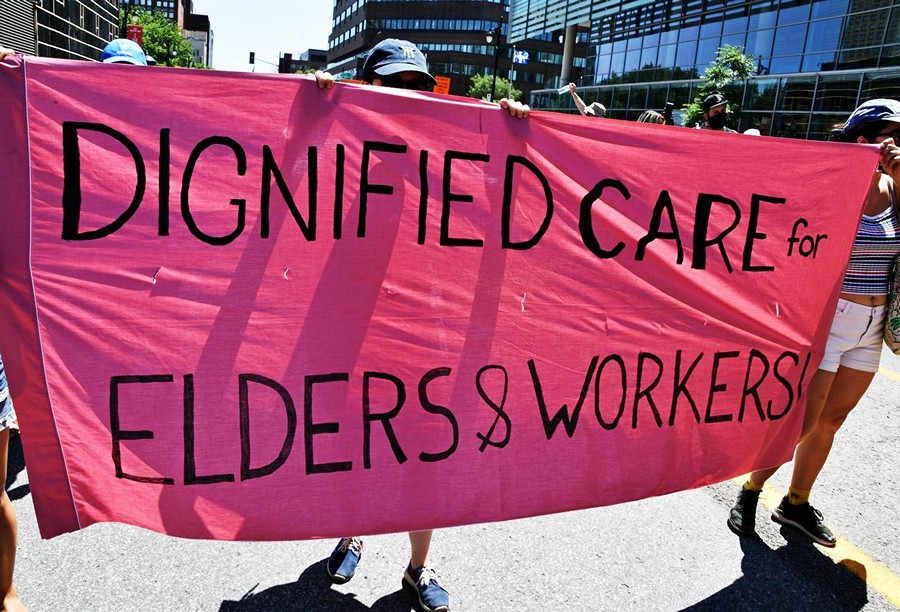 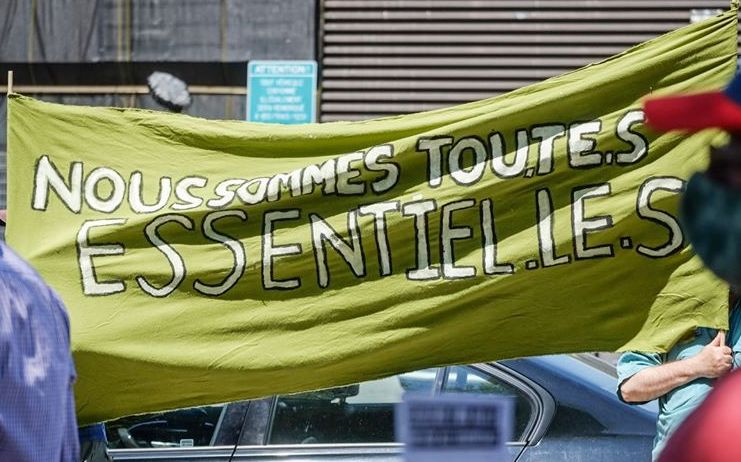
The living and working conditions of many of
these essential workers are intolerable, the result of their
precarious status and unjust immigration laws and regulations that are
continuously changing to suit the demands of employers and the economy.
Rather than being treated with dignity and as human beings should be,
governments and the tiny ruling elite they represent consider these
workers to be expendable, a commodity to use and then discard.
These essential workers are demanding that their contribution to Quebec
society be recognized, not only economically but also culturally and
socially.
 Because of huge
public support for these workers, both the Quebec and Canadian
governments want to be seen as recognizing their contribution during
the pandemic but thus far, have done nothing concrete to assist them.
Many continue to be threatened with deportation, as a representative of
the Committee of Guineans United for Status pointed out. And if members
of his community are deported, they face violence in their home country. Because of huge
public support for these workers, both the Quebec and Canadian
governments want to be seen as recognizing their contribution during
the pandemic but thus far, have done nothing concrete to assist them.
Many continue to be threatened with deportation, as a representative of
the Committee of Guineans United for Status pointed out. And if members
of his community are deported, they face violence in their home country.
A member of the movement Quebec Is Us Too! informed the crowd of the
plight of international students and temporary foreign workers whose
future here in Quebec is being jeopardized by recent arbitrary changes
to the Quebec Experience Program (PEQ) by the Legault government.
International students have also been left without any support from the
federal Liberal government during the pandemic, other than the
possibility of working full time in an "essential service," often at
the risk of their own health due to the lack of protective equipment
and social distancing afforded them. Many of these essential workers
cannot even access public health care.
They stressed that long before COVID-19 began, they were essential and
have courageously continued to care for others and to ensure that food
is provided for everyone. Many have come here lured by the prospect of
a brighter future for themselves and their families, only to find the
tables have been turned on them and they no longer qualify to
permanently settle here.
Solidarity Across Borders pointed out: "Non-status people are pushed
into working very hard for the success and development of the Canadian
economy, on the front lines, in dangerous and dismal working
conditions, without health care, benefits, or emergency relief. Even
while everyone stayed home to protect themselves from COVID-19, many
among us were forced to face the danger, and thus allowed Canadian
society to continue functioning. Unfortunately, no one thought to
compensate non-status people for the great efforts they made, nor
recognized them as full human beings who should be entitled to the same
as everyone else. People without status are entitled to full
recognition, esteem, and respect.
"We come together to say that, the injustice, discrimination, and
exploitation of non-status people must stop! We unite our forces and
our voices to demand a comprehensive regularization programme. Status
for all!"

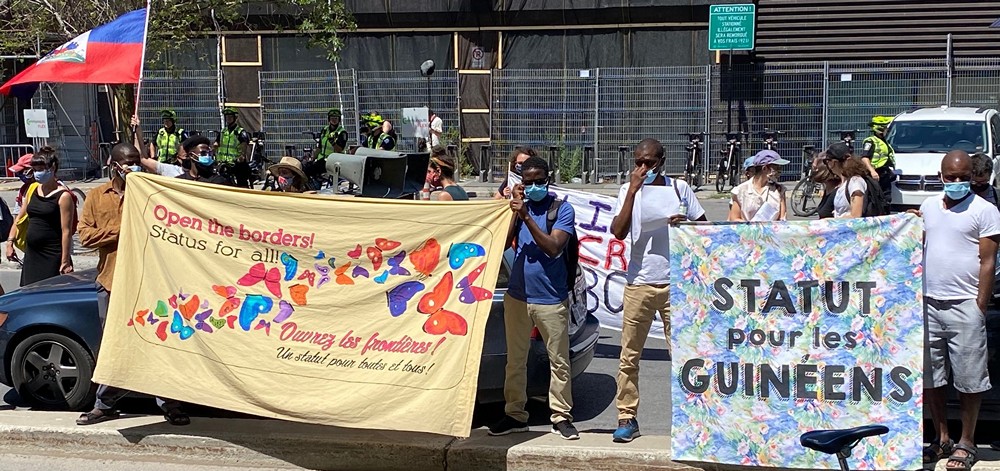
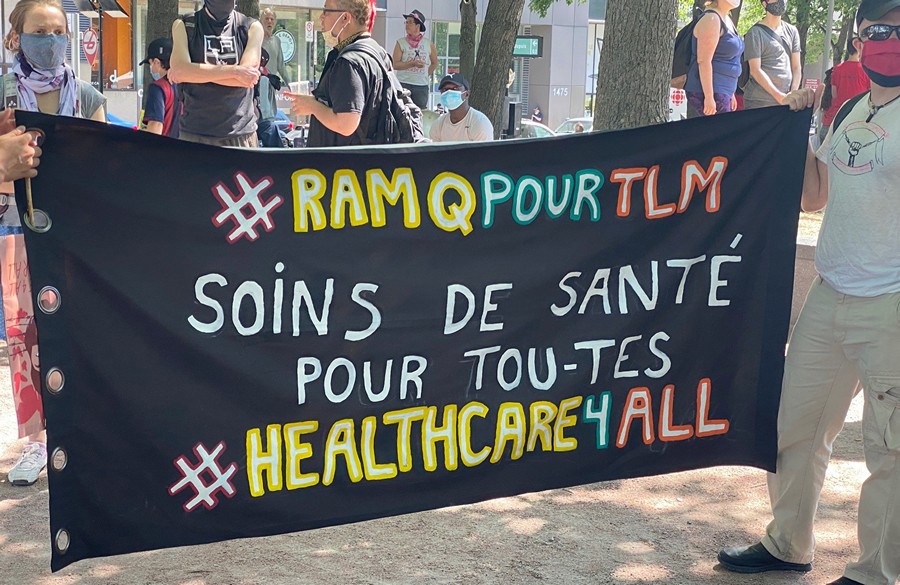 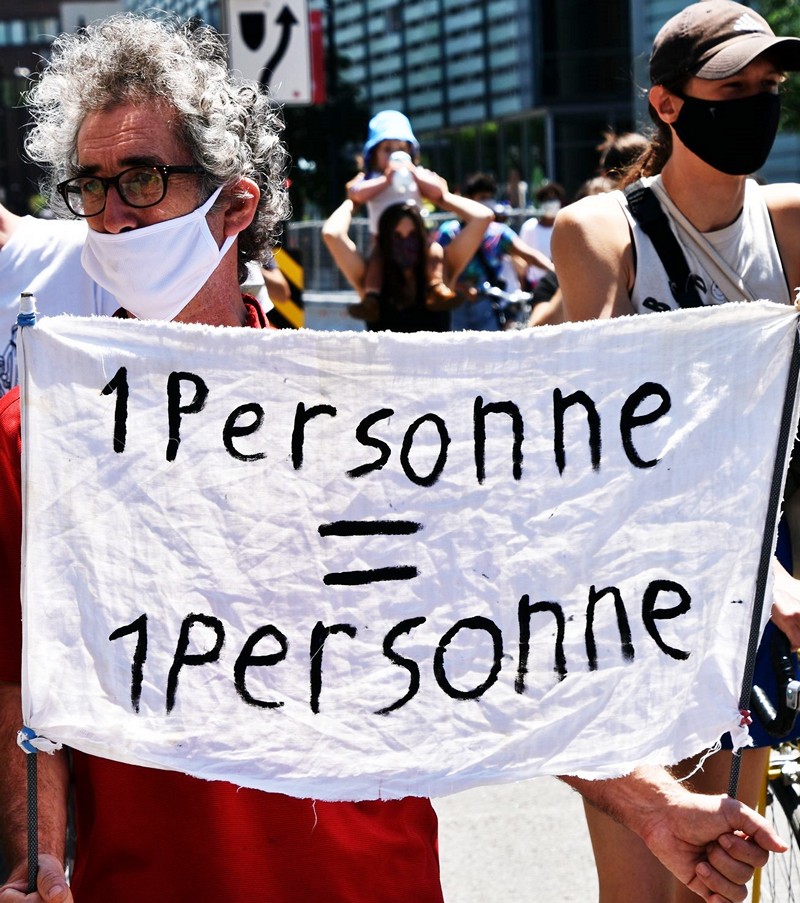
Toronto, Ontario
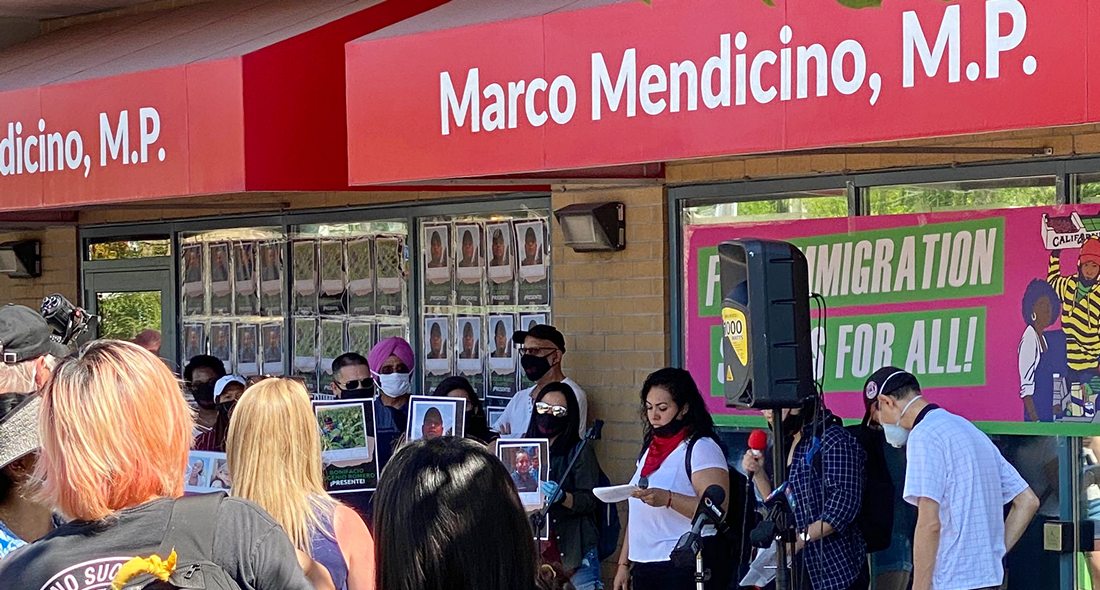
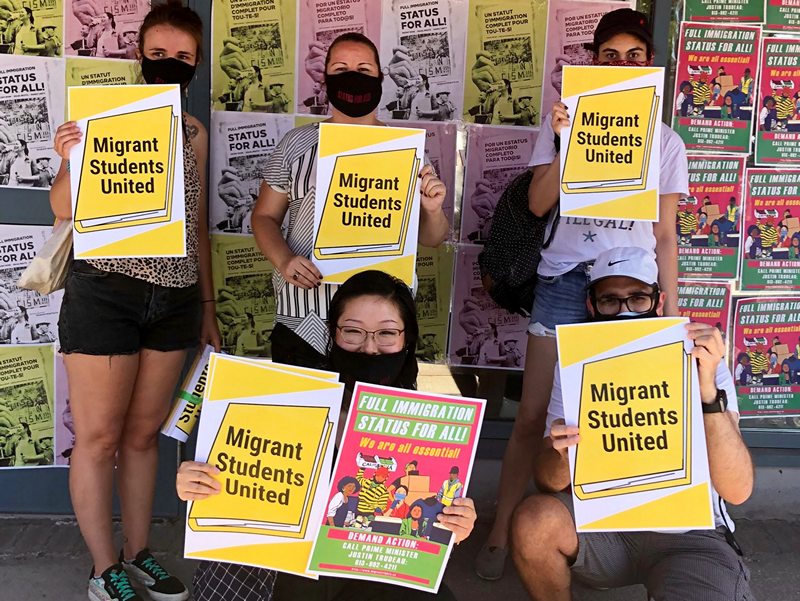 
 
Steveston, BC
People from various parts of the Greater
Vancouver Area travelled to Steveston on July 4 for a rally
outside the office of Steveston-Richmond East MP Kenny Chui. The action
was organized in response to the call from the Migrant Rights Network
for actions across the country. Chui's office was chosen because the
Steveston-Richmond area has a large number of farms that employ
seasonal agricultural workers, and because Chui is a member of the
parliamentary Standing Committee on Citizenship and Immigration.
Demonstrators called attention to the conditions of live-in caregivers,
farm workers and other migrant workers along with the seasonal
agricultural workers.
Besides those who occupied the street in front of the MP's office,
there were others who joined in from cars parked along the street,
adorned with signs such as Justice for Migrant Workers! and Our
Security Lies in the Fight for the Rights of All!
The demonstrators demanded full immigration status for all -- seasonal
agricultural workers and other migrant workers including international
students, refugees, asylum seekers and undocumented workers -- along
with access to health care and social services, Employment Insurance
and labour standards. Speakers at the rally encouraged
everyone to sign the petition issued by the Migrant Rights Network and
to phone Prime Minister Trudeau to demand that the government provide
full immigration rights for all migrant workers.

7th Anniversary of
Lac-Mégantic Tragedy
- Pierre Chénier -
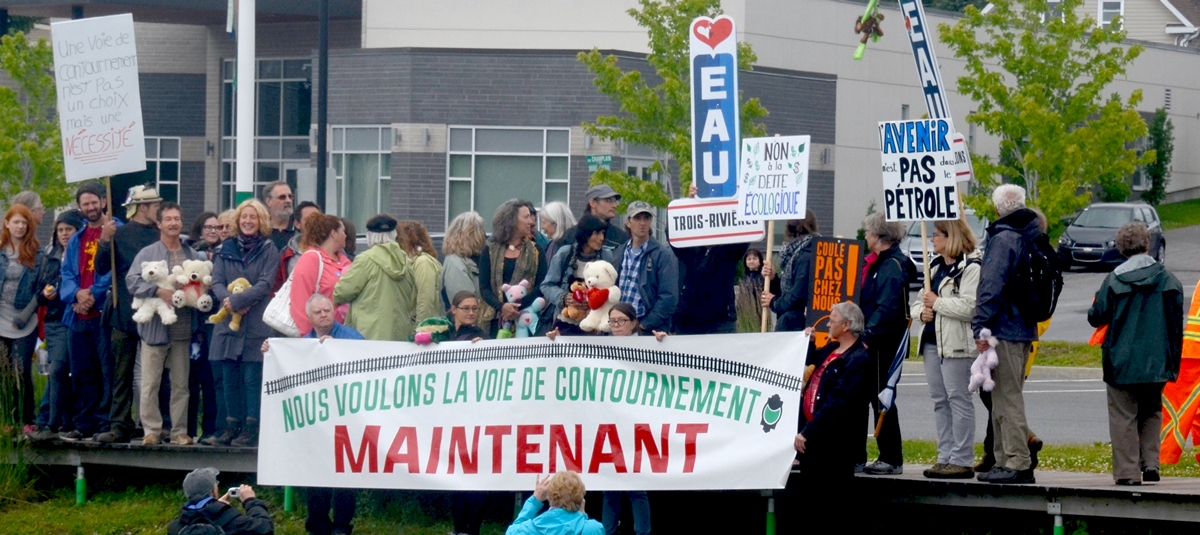
July 6, 2020 marked the seventh anniversary of
the Lac-Mégantic tragedy, one of the worst train disasters
in Canadian history.
On the evening of July 5, 2013, a freight train
comprised of five locomotives and 72 tanker cars, unsuited for the type
of crude oil they carried, was left unattended in Nantes, in Quebec's
Eastern Townships. At around 1:00 am the train started to roll down the
slope towards the town of Lac-Mégantic. Shortly after, 63 of
the tanker cars derailed in downtown Lac-Mégantic, spilling
their contents and causing a series of fires and explosions of
catastrophic proportions.
Forty-seven people were killed and many others
were injured. Downtown Lac-Mégantic was destroyed. The
Chaudière River and the lake itself were heavily
contaminated by the crude oil spill.
The people of Lac-Mégantic suffered
heavy loss of life and property as well as environmental destruction
because of the frenzied pumping of crude oil in North Dakota's Bakken
fields to serve the U.S. war machine and the machinations of
the U.S. against sovereign nation-building projects such as
that of the Venezuelan people. Suddenly, old worn-out tracks
were declared perfectly suitable for such shipments, unsuitable tanker
cars became suitable, and years of state-organized rail industry
deregulation served rail and oil monopoly greed and prepared the
conditions for the disaster.
On this occasion of the seventh anniversary of the
tragedy, the people of Lac-Mégantic held commemorative
ceremonies and reiterated their urgent demands for rail safety. They
have been fighting without ceasing since the tragedy of July 6, 2013 to
rebuild their lives, which cannot be done without improved rail safety
and without a say and control by the community over the measures that
are to be taken.
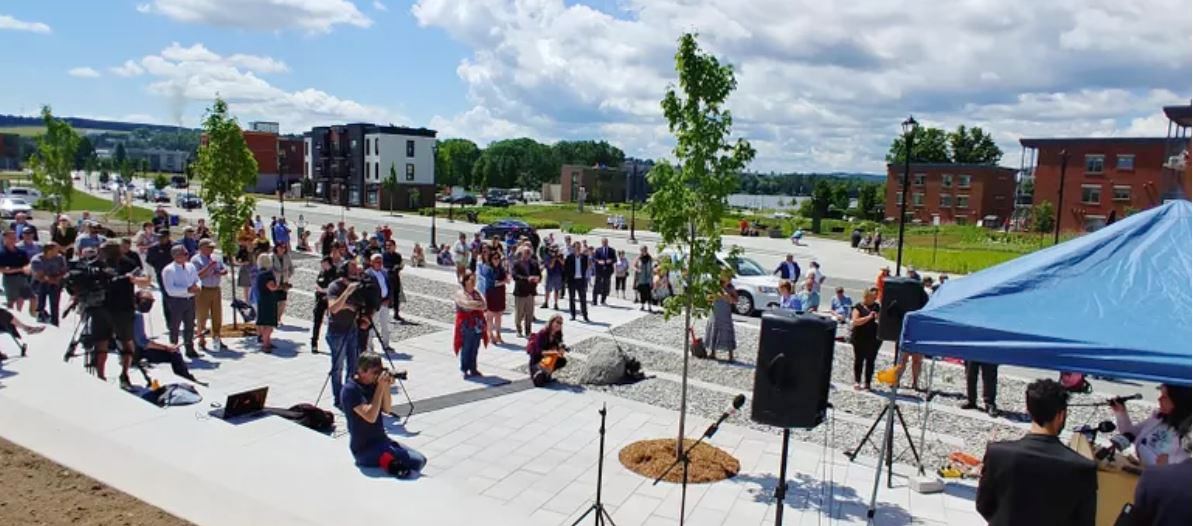
On the occasion of the 7th anniversary the city of Mégantic
inaugurated an Espace
mémoire,
dedicated to the 47 victims.
A main demand is for a bypass track, which the
federal and Quebec governments have now committed to build by 2023, so
that dangerous goods will no longer be transported through
Lac-Mégantic's downtown core. Rail communities affected by
train derailments -- which continue to occur regularly across Quebec,
Canada and the United States -- are greatly inspired by the
steadfastness of the Lac-Mégantic community, backed by all
of the people of Quebec.
The fight of the Mégantic people and of
so many rail communities is difficult and challenging as they are up
against the state-organized deregulation of the rail industry in the
service of rail monopolies and the oil and gas industry. They are also
up against the biggest challenge of all which is that governments no
longer constitute a public authority. They are a wing of the narrow
private interests which have usurped the state apparatus.
The conditions for the Lac-Mégantic
tragedy were prepared during thirty years of wrecking activities by the
state and the rail monopolies.
To name just a few, in the 1990s, national rail
companies such as CP and CN were allowed by the Liberal government to
get rid of regional lines under the hoax that they were not profitable.
Some were sold to vulture U.S. companies in the business of buying and
selling rail companies, which cut the workforce, did not maintain the
lines and lowered safety standards. When CP got rid of many regional
lines, the regional line that includes Lac-Mégantic ended
up, in 2003, in the hands of the Montreal, Maine and Atlantic Railway
(MMA), the owner at the time of the Lac-Mégantic tragedy.
In 2001, the Liberal government at the time
introduced the Safety Management System (SMS), a self-regulating safety
system that rail companies themselves devise and which Transport Canada
merely audits and whose content is kept secret from the workers and
communities with the ruse that this is to protect the competitiveness
of the rail companies.
In 2012, the Harper government authorized MMA to
run its trains with a one-man crew. Again the conditions that had to be
met for the government to grant the authorization were never made
public, under the sham of protecting MMA as a private business.
Anti-social concepts such as "risk management,"
"safety as a cost that has to be balanced against the other costs
companies have to pay," and "competitiveness" have become the name of
the game at the expense of the rights and safety of, and in spite of
the voice of the communities.
Today, claiming these are private business
decisions, the Canadian government is turning a blind eye and letting
CP, for example, put maximum pressure on office workers to drive and
load trains instead of hiring professionally trained locomotive
engineers. Near-miss tragic accidents have been reported but this is
all part of "risk management" under which everything is declared fine
until tragedies happen and governments and companies express sorrow and
concerns and nothing changes. Rail companies are now using
inexperienced people equipped with remote control belt packs walking
alongside trains to assemble and disassemble trains in yards, instead
of having experienced locomotive engineers direct the operation from
the locomotive itself. This has led to an increase in runaway trains.
 The fact is that
seven years after the Lac-Mégantic tragedy, the dangers to
human life, property and the environment are even more acute due to the
criminal negligence of the railway monopolies, supported by
governments. They claim their overriding responsibility and most urgent
task is to remain competitive with other carriers nationally and
internationally at any cost, with governments taking no responsibility
and refusing to hold the monopolies to account. They also claim more
and more that the human factor is the cause of accidents and tragedies
and that unless the process is 100 per cent mechanized, with no workers
involved, rail safety will continue to deteriorate and be subject to
"human error." The fact is that
seven years after the Lac-Mégantic tragedy, the dangers to
human life, property and the environment are even more acute due to the
criminal negligence of the railway monopolies, supported by
governments. They claim their overriding responsibility and most urgent
task is to remain competitive with other carriers nationally and
internationally at any cost, with governments taking no responsibility
and refusing to hold the monopolies to account. They also claim more
and more that the human factor is the cause of accidents and tragedies
and that unless the process is 100 per cent mechanized, with no workers
involved, rail safety will continue to deteriorate and be subject to
"human error."
Workers and communities reject this anti-social
outlook and these anti-social practices. It is thanks to their
activation of the human factor/social consciousness that the demand to
provide real problems with pro-social solutions exists and is firmly
planted as the basis for opening a path to progress. Even as
workers and communities keep pushing their immediate demands for
measures to enforce safety in terms of working conditions, required
personnel, maintenance of the tracks, safe stationing of trains and the
bypass track, they continue to suffer the daily trauma of repeat
accidents because of the government's anti-human approach to the
problem. The trauma they suffer is not just post-traumatic, but the
present foreboding that at any time the mischief could be
repeated.
Any authority worthy of the name must
have mechanisms that enable those affected by the decisions taken to
have the decisive say over what decision is to be taken, how it is
implemented and how it is monitored. Governments and the
narrow private interests they serve must be held to account for their
anti-human, anti-social and irresponsible response to the demands of
the Lac-Mégantic community.
Lac-Mégantic was a tragic and profound
eye-opener as to how the neo-liberal outlook and practice of placing
all of society's assets at the disposal of the global monopolies
directly led to the self-regulation of the railways and to criminal
negligence causing death and chaos, as well as joint attempts by the
private owners and the government to blame the workers. The people of
Lac-Mégantic have faced the tragedy with immense courage and
with the support of people from all over Quebec, Canada, the U.S. and
the world. All together, the people are fighting to put an end to these
tragedies by empowering themselves so that they can exercise control
over their lives.
On the occasion of the seventh anniversary of the
tragedy, our warm salute to the Lac-Mégantic community who
continue to rebuild their lives and to make an important contribution
to the fight for the security of all.

- Interview, Robert
Bellefleur, Spokesperson for the Coalition of Citizens
and Organizations Committed to Railway Safety in
Lac-Mégantic -

TML Weekly: First
of all, our best wishes to the people of Lac-Mégantic who
are fighting so bravely to rebuild their lives, which cannot be done
without improved rail safety. What was organized in the city for the
seventh anniversary of the tragedy?
Robert Bellefleur:
There were three press conferences. Of course, we held our own. The
Alliance ferroviaire de l'Estrie et Montérégie,
which includes the mayors of Mégantic, Sherbrooke, Bromont,
Cowansville and Farnham, also held one, as did the city of
Mégantic, which inaugurated the Espace mémoire,
a structure dedicated to the 47 victims. It is located where
the tragedy took place, on the very foundations of Musicafé.
At noon, after the inauguration of the Espace mémoire, bells
were rung 47 times in memory of the 47 victims of the tragedy.
TMLW: What
are the challenges you are facing at this time in ensuring rail safety?
RB: We took
another tour of the track and found new problems with the rails. A
second formal notice was sent to Transport Canada to come and
re-inspect the rails at the entrance and exit of
Lac-Mégantic. On May 7, 2019, Transport Canada sent a report
to Central Maine and Quebec Railway Canada (CMQR) noting 253 defective
rails between Farnham and Lac-Mégantic. The company was to
repair this. In August, it was discovered that a location specified in
the report where the rails were defective had still not been repaired.
We also produced a video showing the condition of the rails at that
time.[1]
This was reported to Transport Canada and the
media and two weeks later a train partially derailed at the same
location. The wheels just left the track. After that, a formal notice
was sent to Minister of Transport Marc Garneau and a ministerial order
was issued to force the company to make repairs. That was last year.
This year, we are doing the same thing. We are sending a formal notice
to Garneau, a second one, to tell him that you have not repaired
everything. There's still some left. There's a lot left. We sent him
the formal notice yesterday. He now has 10 days to do a new inspection
that goes beyond the standard ultrasonic inspection. Ultrasound is a
method that is not completely effective when the rails are too worn
because the metal no longer conducts the waves properly.
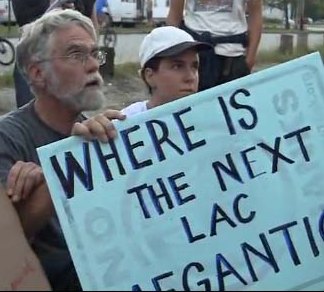 According to an
expert report on the seven major derailments of oil-carrying trains in
Canada that have occurred since the Mégantic
derailment, which was presented in a CBC report on June 15, the
condition of the rails is responsible for the derailments. This is
because the railway safety regulations on which the maintenance
standards are based date back to 2012, that is, before the massive
transportation of oil on the rails. The regulations are written based
on the old practice of regular freight trains and have not been
adjusted to the new reality of massive oil transportation. So the rails
wear out faster with characteristic breakages due to the overweight
trains. So the Transportation Safety Board of Canada made that
observation and recommended that the railway safety regulations be
reviewed because they no longer correspond to reality. These
regulations govern the companies and define maintenance standards.
Journalists have proven that these seven major derailments since
Mégantic are due to the fact that maintenance protocols are
not up to date and that the trains are heavier and longer. The CMQR
boasted that the weight of its trains passing through
Mégantic had increased by 56 per cent. According to an
expert report on the seven major derailments of oil-carrying trains in
Canada that have occurred since the Mégantic
derailment, which was presented in a CBC report on June 15, the
condition of the rails is responsible for the derailments. This is
because the railway safety regulations on which the maintenance
standards are based date back to 2012, that is, before the massive
transportation of oil on the rails. The regulations are written based
on the old practice of regular freight trains and have not been
adjusted to the new reality of massive oil transportation. So the rails
wear out faster with characteristic breakages due to the overweight
trains. So the Transportation Safety Board of Canada made that
observation and recommended that the railway safety regulations be
reviewed because they no longer correspond to reality. These
regulations govern the companies and define maintenance standards.
Journalists have proven that these seven major derailments since
Mégantic are due to the fact that maintenance protocols are
not up to date and that the trains are heavier and longer. The CMQR
boasted that the weight of its trains passing through
Mégantic had increased by 56 per cent.
TMLW: At
your press conference, you said that the hazardous materials currently
in circulation are even more dangerous than those that exploded during
the tragedy. Can you tell us more about that?
RB: During
the BAPE [Office of Public Hearings on the Environment] meetings in
Mégantic last year, the experts who were conducting a risk
study told us that the two most dangerous materials circulating on the
rails are propane gas and sulphuric acid. There is nothing worse than
that. If ever there is a derailment followed by an explosion of these
materials, the sulphuric acid will spray into the atmosphere as a
vapour and the winds will push this up to 20 or 30 km. This is much
more dangerous than the shale oil burning on site. It's ten times worse
as an impact.
We see convoys of 30 tanks, where 10 to 12 cars
contain propane gas and seven to eight cars contain sulphuric acid,
transported by DOT-111 cars. Since the explosion at
Lac-Mégantic, these cars can no longer transport oil, but
they are now used to transport a product that is ten times more
dangerous! We see this type of convoy three to four times a week and it
runs on defective rails and culverts.
 It should also be
added that the trains are still parked at the top of the hill. Since
there is no longer a rail yard in
downtown Mégantic, the company is shunting in
Nantes, at the same place where the death train was parked on July 6,
2013. It parks cars from the industrial park on the service track and
when the train arrives from the United States with the dangerous
material, they stop parallel to them on the main track, next to the
cars to be loaded. They apply only air brakes on the slope, no hand
brakes. And there they detach the four locomotives that will pick up
the cars on the other track, leaving the whole train alone, on simple
air brakes on the grade, from 45 minutes to one hour. That's how long
it took, when the firemen left Nantes, for the train to go down the
slope in 2013. These manoeuvres are carried out two to three times a
week in Mégantic. We are in the same scenario. Nothing has
really changed, except that the materials are 10 times more dangerous.
I have reported this twice to the City of Mégantic and
Transport Canada. We also see it in the video. It should also be
added that the trains are still parked at the top of the hill. Since
there is no longer a rail yard in
downtown Mégantic, the company is shunting in
Nantes, at the same place where the death train was parked on July 6,
2013. It parks cars from the industrial park on the service track and
when the train arrives from the United States with the dangerous
material, they stop parallel to them on the main track, next to the
cars to be loaded. They apply only air brakes on the slope, no hand
brakes. And there they detach the four locomotives that will pick up
the cars on the other track, leaving the whole train alone, on simple
air brakes on the grade, from 45 minutes to one hour. That's how long
it took, when the firemen left Nantes, for the train to go down the
slope in 2013. These manoeuvres are carried out two to three times a
week in Mégantic. We are in the same scenario. Nothing has
really changed, except that the materials are 10 times more dangerous.
I have reported this twice to the City of Mégantic and
Transport Canada. We also see it in the video.
All this is tolerated by Transport Canada.
Yesterday, July 5, Garneau broke his silence and issued a press release
to defend himself, in which he said that there have been 225
inspections of the railway track between Farnham and
Lac-Mégantic since 2015, that is 45 per year. I said in an
interview that either the inspectors are blind or they are incompetent
and inconsistent, which I doubt, or the rules are not strict enough and
are too complacent toward the companies.
TMLW: Can you explain the
status of the bypass track?
RB: It's
stalled. What I have learned is that following the BAPE report in May
2019, many questions were raised about the environment with
regard to the route of the bypass as it crosses wetlands, which are
protected in Quebec. The Quebec Ministry of the Environment expressed
reservations on certain points and asked for clarification. And that is
where it gets stuck. Transport Canada issued a ruling last year on the
proposed expansion of the port of Quebec in Beauport Bay, where fish
will spawn. The court ruled that Quebec has no business interfering in
a federal jurisdiction. And now Transport Canada is using this ruling
to say that it does not have to take into account the environmental
concerns of the BAPE and the Quebec Department of the Environment.
In our opinion, the concerns raised about the
environment must be treated seriously. We must consider that the bypass
will cross rivers, streams, swamps and farmland. Ditches will be dug,
wooden ties soaked in creosote will be installed in these ditches and
it will flow into the Chaudière River.
The coalition's opinion is that this railroad
could be built with concrete ties. Concrete has an environmental impact
when you make it, but once it is placed in an environment, it is inert.
Look at the REM [Metropolitan Express Network] in
Montreal on the south shore, they used concrete ties. [REM is
a light rail rapid transit system under construction in the Greater
Montreal area -- TML Ed. Note] In Ontario, new railways are
also built on these types of sleepers. And here we are still using the
methods from the last century. It is important to know that wooden ties
have an average life of 20 to 30 years, whereas concrete can last more
than 50 years. Moreover, when the life of wooden ties is over, there
are still toxic products in them, PAHs -- polycyclic aromatic
hydrocarbons, which are carcinogenic. To dispose of them, you have to
take them to a high-efficiency incinerator, so it costs a fortune to
get rid of them.
All the pressure we're putting on is to say that
the old railroad tracks are dangerous. We're not going to wait three
years. They have to be forced to speed up the process of creating the
bypass. We are told that it is planned for 2023.
TMLW: Do you
want to say anything in conclusion ?
RB: In the
absence of Transport Canada oversight, it is always the citizens who
remain vigilant. It is citizen involvement and action that remains to
ensure safety in the absence of Transport Canada's involvement. The
authorities are ignoring safety, so it is the citizens who must see to
it.
We continue the fight. They said
the Mégantic people were resilient. We'll show them
what resilience is!
Note
1. To view the video Lac-Mégantic,
a Railroad at the End of its Life click here.
To see a video on the reconstruction of Lac
Mégantic on a modern basis click here.

30th Anniversary of the
Brutal Military Assault on the
Mohawk at Kanehsatà:ke
- Fernand Deschamps -
"The plight
of the Indigenous peoples of this country is a matter of great concern
to everyone. This includes the Trudeau government. Unfortunately, the
government's concern is not to redress historical wrongs as the times
demand. It is to achieve
what has eluded previous governments -- which is to extinguish
Indigenous peoples' rights once and for all, so as to steal their lands
and resources. At the same time,
Prime Minister Justin Trudeau seeks to restore Canada's tarnished human
rights
record on the world stage. This is a reputation as a violator of human
rights due to its
abysmal record of criminal negligence of the conditions of life of the
Indigenous
peoples in Canada and crimes committed against them." -- Pauline Easton[1]
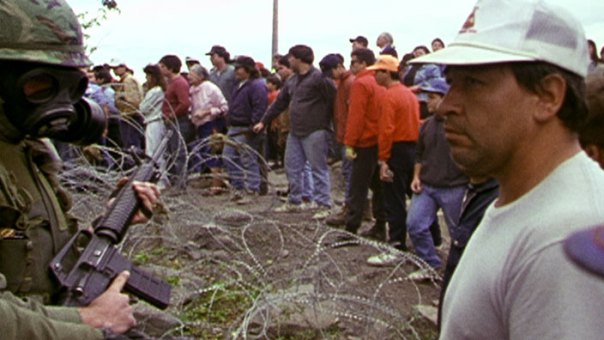 
Oka 1990
Thirty years ago, at dawn on July 11, 1990, about
100 heavily armed officers of the Sureté du
Québec (SQ) attacked members of the
Kanien'kehá:ka of Kanehsatà:ke (Mohawk nation,
member of Haudenosaunee Confederacy) who had set up a blockade on a
dirt road leading to a sacred Indigenous burial site to oppose the
expansion of a golf club on Mohawk territory located close to the town
of Oka, Quebec. For the project to proceed, the forest known as the
Pines, as well as the Pine Hill Cemetery, the community of
Kanehsatà:ke's graveyard, would have to be bulldozed. To
prevent this destruction, people of Kanehsatà:ke erected a
barricade on a small, secondary dirt road through the Pines, as early
as March 1990.
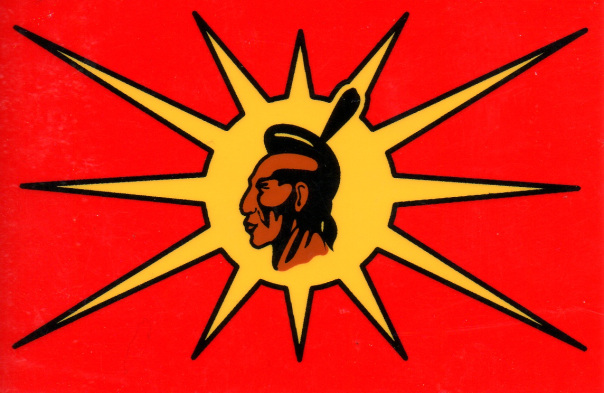 The July 11 SQ
raid came after an ultimatum, in the form of a court order that the
mayor and municipal council of Oka had sought which supported the
expansion of the private golf course on stolen Indigenous land: the
Kanien'kehá:ka of Kanehsatà:ke had to bring down
their barricade by July 9 or else face the full force of the law. The July 11 SQ
raid came after an ultimatum, in the form of a court order that the
mayor and municipal council of Oka had sought which supported the
expansion of the private golf course on stolen Indigenous land: the
Kanien'kehá:ka of Kanehsatà:ke had to bring down
their barricade by July 9 or else face the full force of the law.
During the July 11, 1990 assault by the police force in full military
combat gear, the SQ used tear gas and concussion grenades on the people
at the barricade.
After the SQ started shooting, a firefight broke out between them and
the Mohawk Warriors and SQ Corporal Marcel Lemay was shot and killed in
the melee.
The SQ abandoned their vehicles and retreated to the bottom of the hill
to Oka. The warriors used the abandoned vehicles to build and fortify a
new barricade on Highway 344, while the SQ erected a barricade of their
own to try to prevent Mohawk reinforcements from coming to
Kanehsatà:ke. As a show of solidarity, the Mercier Bridge,
one of the five bridges/tunnel linking Montreal to the South shore of
the St. Lawrence River, was shut down in Kahnawà:ke by the
Mohawk community there. The events are recalled in the 1993 National
Film Board documentary entitled Kanehsatake: 270 Years of
Resistance, directed by Alanis Obomsawin who was in
Kanehsatà:ke when the confrontation took place in 1990.[2]
The standoff in Kanehsatà:ke and Kahnawà:ke
included thousands of soldiers of the Canadian Army with tanks and
helicopters ordered by the Mulroney government at the request
of the Bourassa government. It lasted until September 26 when the
members of the Onen'to:kon Treatment Center in Kanehsatà:ke
decided to walk out of the encirclement after 78 days of resistance.
 
Oka 1990
The Unsettled Issue of Land Claims
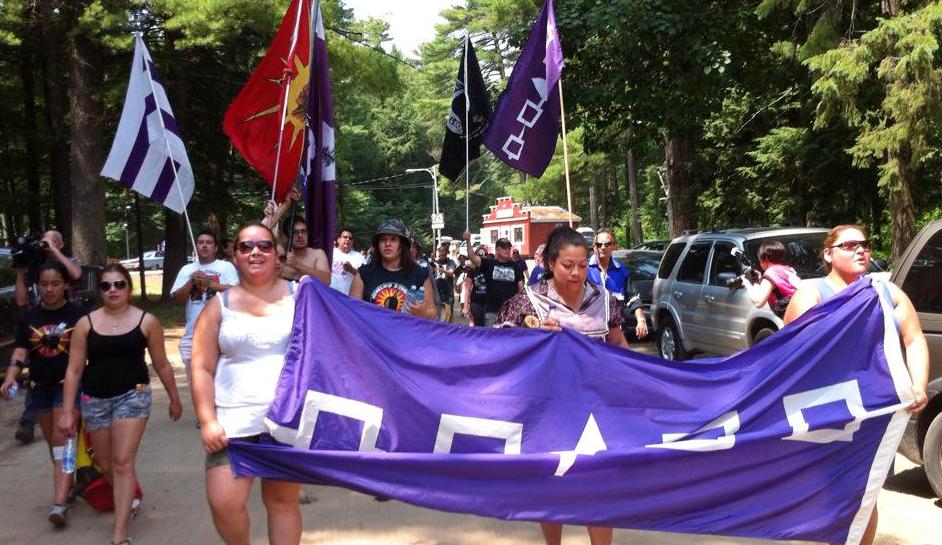
March marks 25th anniversary of Oka uprising, July 11, 2015.
Although the siege ended, the land
issues that were at the core of the dispute persist to this day. The
land issue in Kanehsatà:ke dates back 300 years, when the
Sulpicians began the slow process of dispossessing the Mohawk Nation of
Kanehsatà:ke of their lands.[3]
"Nothing has changed,"
Kanehsata'kehró:non Ellen Gabriel said earlier this week,
reflecting on the 30th anniversary of the start of the
Kanehsatà:ke siege, or what many refer to as the "Oka
Crisis." She was part of those who resisted during the 1990 siege and
participated during that period in negotiations with the Quebec and
federal governments to settle the land claims.
"How can Reconciliation have
failed, if it never even started?" Gabriel asked. In a previous
statement she said, "Reconciliation includes reparations and
restitution."
What she was referring to is that
after 30 years the federal government has failed to find solutions to
Kanehsatà:ke's land dispute. Gabriel said a nation-to-nation
relationship means meeting with the Haudenosaunee Confederacy.
The Demand for a
Moratorium on the Sale of Land

Press conference about illegal pipeline expansion on traditional
Kanien'kehá:ka Territory,
September 28, 2017.
In a news
conference almost a year ago, on August 21, 2019, Ellen Gabriel, on
behalf of the People of the Longhouse in Kanehsatà:ke, said
that she wanted the federal government to stop the development and sale
of over 689 square kilometres of the ancestral territory located 40
kilometres northwest of Montreal.
"We caution anyone
who decides to purchase land in Kanehsatà:ke,
Kanien'kehá:ka homelands, or Oka and its surrounding
municipalities of buyer beware, as this whole area remains contested
land," said Gabriel.
She added that the
federal government has long neglected her community's land grievance,
which resulted in the 1990 Oka Crisis.
"The prime minister
is allowing land fraud to continue," said Gabriel.
"Reconciliation
means a genuine commitment to change, to honestly engage and
re-conceptualize relationships to create a future of peace, justice and
renewed hope."
In an earlier
interview with CBC during that same month, Serge Simon, grand chief of
the Mohawk Council of Kanehsatà:ke, said, "The federal
government has a fiduciary responsibility to all First Nations people,
and here what you see is the lack of fiduciary responsibility."
The unresolved land
dispute at the heart of the "Oka Crisis" 30 years ago prompted one
Ojibway man from Shoal Lake, Ontario to start a two-week hunger strike
on October 11, 2019 with one of the key demands that Canadian Prime
Minister Justin Trudeau place a short-term moratorium on all land
development on Kanien'kehá:ka homelands in
Kanehsatà:ke.
"The longstanding
historical land dispute which was the crux of the 1990
Kanehsatà:ke Siege, or Oka Crisis, has never been resolved,"
the Longhouse in Kanehsatà:ke said in a statement the same
day. This point was emphasized by Longhouse member Ellen Gabriel, that
a moratorium on all development within the area under dispute must be
put in place until the land claim is resolved. She said more land has
been developed in the area in recent years than what they opposed in
1990.
"Let's settle the
land dispute that was promised during the negotiations in 1990, so
people can get on with their lives and we don't have to keep worrying,"
she said.
"It's the first
stage. The ultimate goal is to live in peace."
The
Comprehensive Claims Policy as a Means to
Divide Indigenous Peoples
The
Mohawk community's claim to the land known as the Seigneury of Lake of
Two Mountains was first filed with the federal government in 1975.
After being rejected and refiled a number of times, a part of the claim
referred to as the "small commons" was officially accepted under
Canada's Specific Claims Policy for formal negotiations in 2008.
However, the policy allows only band councils to file a claim, not the
age-old traditional forms of governance established by the Indigenous
peoples themselves.
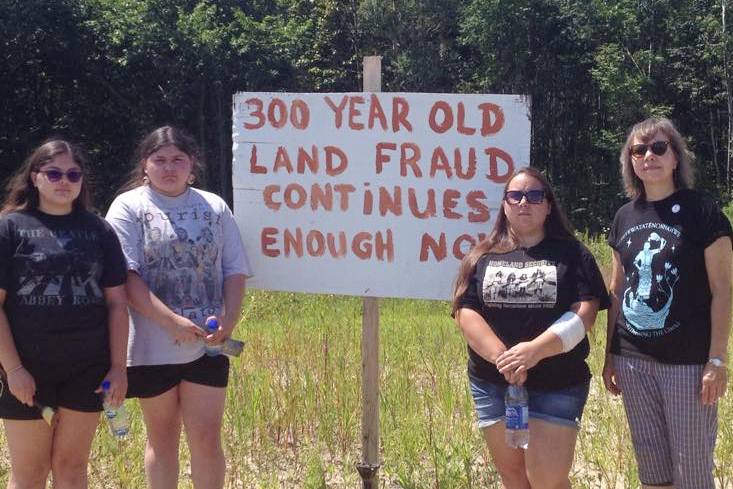 Joe Deom, a representative of the Mohawk Nation in
Kahnawà:ke, said women hold the title of the land under
their constitution -- the Kaianere'kó:wa or Great Law of
Peace -- which precedes European arrival in North America.
Joe Deom, a representative of the Mohawk Nation in
Kahnawà:ke, said women hold the title of the land under
their constitution -- the Kaianere'kó:wa or Great Law of
Peace -- which precedes European arrival in North America.
"All
of this land that surrounds us here really comes under the jurisdiction
of the women of the Longhouse and not the band councils, not the
federal government and not the province," he said.
Also, the lack of information available about ongoing specific claim
negotiations was one of many issues on which the people of
Kanehsatà:ke felt a lack of confidence in their band council.
Gordie Oke, a former council chief, said that's because of a
confidentiality clause the band council had to sign when entering the
negotiation process for the claim.
"It
bothered me because we always have to consult our people about any type
of issues coming forward by the feds," said Oke.
Marc
Miller, then parliamentary secretary to Minister of Crown-Indigenous
Relations and now Minister of Indigenous Services, in answer to the
fact that First Nations are not consulted in this process, said
"[Negotiations] are confidential. One major reason is it offers the
sides a forum to have face-to-face discussions and not have a process
where you're negotiating in the public domain through media." For
someone who likes to boast about his knowledge of Mohawk language, he
should look up how the word "transparency" translates in Mohawk
traditions.
Peter Di Gangi, a board member at the First Nations-led research
centre, Yellowhead Institute, said the confidentiality agreements are
an issue: "The claims are against the federal government. At the same
time, it controls the negotiation process, controls the funding. It
controls just about every aspect of the process," said Di Gangi.
"That has an impact on the ability of First Nations to feel that they
have an opportunity to have their claims addressed in a fair and open
manner."
In
places like Quebec, underlying Aboriginal title to the land also
complicates situations when the federal government seeks a "release"
with regard to the claim when a settlement is reached.
"For
some communities, it's viewed as a form of extinguishment," said Di
Gangi.
"If
you have underlying Aboriginal title and are sitting at the table with
the government to resolve a specific claim, why would you want to
release your underlying title just to settle a reserve claim?"
A
year ago, the federal government attempted to introduce what they
called "new comprehensive land claims and inherent rights policies."
As TML
Weekly pointed out at that time "The National Day of Action
[...] oppose(s) what has been dubbed 'Trudeau's White Paper 2.0.' This
includes Bill C-86, an omnibus budget implementation bill that contains
amendments to legislation, including the First Nations Land
Management Act and the First Nations Fiscal
Management Act. With the changes the government is
introducing come plans to replace policies dealing with modern treaties
(which it refers to as comprehensive claims) and self-government (which
it calls its Inherent Right Policy). Due to the opposition expressed by
First Nations chiefs, Crown-Indigenous Relations Minister Carolyn
Bennett backed down from the scheduled June introduction of these
changes, which are a blatant violation of the hereditary rights of all
Indigenous peoples."
"APTN
News reports:
"Canada
won't be introducing new comprehensive land claims and inherent rights
policies just yet, Crown-Indigenous Relations [Minister] Carolyn
Bennett told the Assembly of First Nations" on May 2.
[...]
"Speaking about the national day of protest and regional protests,
Okimaw Henry Lewis, Chief of Onion Lake Cree Nation on the
Saskatchewan-Alberta border, said: 'We are working with a network of
nations chiefs across the country to alert our people about what's
happening, and to tell the government that they can't continue to
proceed unilaterally in the development of law policies and agendas
that directly attack our inherent and treaty rights, and sovereign
jurisdiction.'
"Lewis
clearly set the record straight: 'Canada has never stopped trying to
implement their 1969 White Paper policy, which is meant to domesticate
our international treaties, turn us into municipalities and remove us
from our lands,' adding 'We must stand in unity as chiefs and peoples
to fight off this agenda for our children and future generations.'"[4]
To
commemorate the 30th anniversary, the Kanehsatà:ke Longhouse
will be holding a rolling blockade on Saturday, July 11, starting at
10:00 am.
Notes
1."Recognition
of the Hereditary Rights of Indigenous Peoples Must Come First," by
Pauline Easton, TML Weekly, October 3, 2017.
2.
Extracts of the documentary entitled "Kanehsatake: 270 Years of
Resistance."
3. "At the Woods
Edge: An anthology of the History of the People of
Kanehsatà:ke -- The reality of Kanehsatà:ke and
the Myth of 1721," by Brenda Katlatont
Gabriel-Doxtater and Arlette Kawanatatie Van den Hende,
Kanesatake Education Center, 1995, pp 20-23.

World-Wide Protests Condemn
the Annexation of Palestinian Territory
The call of the Palestinian resistance for Days
of Rage protests against the annexation of Palestinian territories has
been taken up worldwide in the days and weeks leading up to and
following the July 1 official "launch" announced by Israel.

A Palestinian land protest in Asirah Alshamaliah Village, July 3, 2020.
Israeli settlers, escorted and protected by soldiers, erected an
illegal colonial outpost on the Village lands a
few days prior.
According to Samidoun, the Palestinian Prisoner
Solidarity Network, protests took place on July 1 in occupied
Palestine; in San Francisco, San Diego, Rancho Cucamonga and Claremont,
California; Chicago, Illinois; Salt Lake City, Utah; Albuquerque, New
Mexico; Portland, Oregon; Boston, Massachusetts; Seattle, Washington;
Philadelphia, Pennsylvania; Toledo and Columbus, Ohio; Halifax
and St. Catharines, Canada; San Jose, Costa Rica; Oldham and Bedford,
England; Toulouse and Saint-Denis, France; Amsterdam and The Hague,
Netherlands; Frankfurt and Berlin, Germany; Madrid, Granada, Valencia,
Valladolid, Sevilla and Bilbao, Spain; Athens, Greece; Istanbul,
Turkey; Johannesburg, South Africa; and Seoul, Korea.
Actions continued after July 1 in Berlin, Germany;
Amman, Jordan; Copenhagen, Denmark; Toronto, Mississauga and Hamilton,
Canada; in many cities across Ireland and the United Kingdom; Auckland,
New Zealand; Detroit and Cleveland, USA; Lisbon, Portugal; and other
places.
Brooklyn, New York saw one of the largest Day of
Rage actions outside Gaza. Thousands of people poured into the streets
shouting slogans and marching for four hours. Organized by the
NY4Palestine Coalition, which includes Samidoun, it specifically tied
the struggle of the Palestinians for their rights with the struggle of
Black Americans against state-organized racist police violence.
Pre-recorded remarks by U.S. political prisoner Mumia Abu-Jamal
signaled the start of the march.

Day of Rage in Brooklyn, New York, July 1, 2020.
In Los Angeles, hundreds of cars with signs,
banners and Palestinian flags drove from the Federal Building to the
Israeli Consulate where a boisterous rally was held.
In Baltimore, protestors condemned U.S. support
for the Zionist state of Israel and demanded an end to the Israeli
occupation of Palestine. They also demanded an end to the training of
Baltimore police by Israeli Defense Forces.
 Samidoun reported
that nearly 300 people rallied in Toulouse, France, on July 1. For
almost two hours, the demonstrators chanted and shouted slogans: "Palestine vivra! Palestine
vaincra!" (Palestine will live, Palestine will win) and
"Boycott Israel!" Samidoun reported
that nearly 300 people rallied in Toulouse, France, on July 1. For
almost two hours, the demonstrators chanted and shouted slogans: "Palestine vivra! Palestine
vaincra!" (Palestine will live, Palestine will win) and
"Boycott Israel!"
Amsterdam was also home to an action on July 1,
where more than 100 people protested at the U.S. consulate against the
continued colonization of Palestine. The protest was organized by
Samidoun Nederland and supported by a number of different
organizations, including BDS Netherlands and the PGNL, the Palestinian
Community of the Netherlands.
In Berlin, youth led a demonstration
on July 3 outside the Bundestag (the German parliament). They
filled the area in front of the Bundestag with Palestinian flags and
with calls for justice and liberation, making it clear that no amount
of repression by the German state, will prevent the voice of Palestine
from being heard.
Samidoun reports that tens of thousands of people
in many different cities around the world took to the streets in
response to the call for Days of Rage against Israeli annexation, from
Palestine to the USA, from the Philippines to Turkey. It is clear that
the ongoing colonization of Palestine will be met with increasing
resistance.
Canada

Toronto, July 4, 2020.
Across Canada, actions continue to be held as
part of the international Days of Rage condemnation of U.S. / Israeli
Zionist plans to annex huge swaths of the occupied Palestinian
territories. Upwards of 300,000 Palestinians are under threat of
further displacement as a result of the proposed annexation. Last week TML
Weekly reported on an action held in Halifax on July 1.
Actions were also held recently in Montreal, Toronto, St. Catharines
and elsewhere. The protests have continued and there have been further
actions in Toronto, Mississauga and Hamilton and one announced for
Vancouver on July 12, and another in Windsor, July 18.
Toronto
 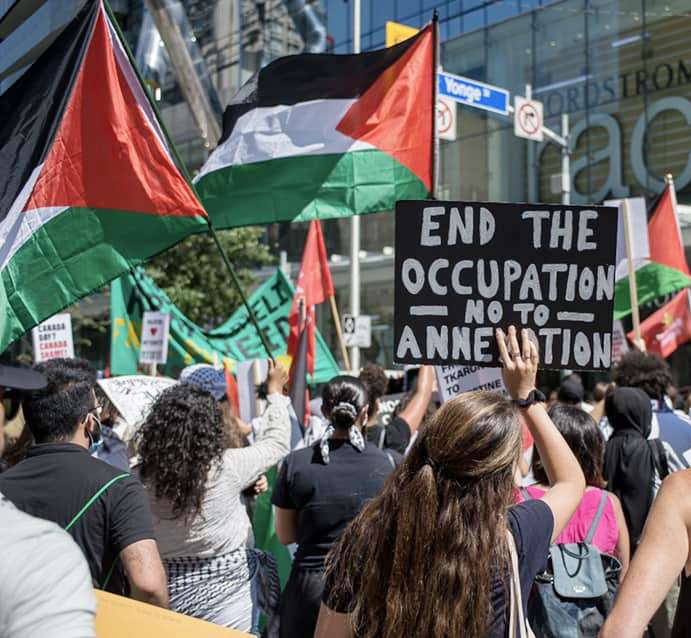
The action in Toronto on July 4 was hosted by the
Palestinian Youth Movement, Arab Palestine Association of Ontario,
Al-Awda: The Palestine Right to Return Coalition, and Campuses for
Palestine (C4P). The spirit of resistance was uplifting.
 One participant
enthusiastically wrote to TML Weekly that it
looked as if over 1,000 people joined in at one time or another over
the course of the three-hour protest. There was a constant presence of
200-250 people present braving the heat, with many passersby stopping
and joining in for shorter periods before going on their way. One participant
enthusiastically wrote to TML Weekly that it
looked as if over 1,000 people joined in at one time or another over
the course of the three-hour protest. There was a constant presence of
200-250 people present braving the heat, with many passersby stopping
and joining in for shorter periods before going on their way.
It seemed like more than 100 different
organizations participated in this act of solidarity and resistance.
"They included all manner of communities suffering from all manner of
colonialism, racism, sexism, discrimination. Speakers included Black,
Indigenous, non-Zionist Jews -- practically every marginalized,
discriminated-against community you could think of."
Mississauga
 
A vigorous, lively, "Protest for Palestine" was
held in Mississauga on July 4 at Celebration Square, organized by Sauga
for Palestine. The organizers, primarily students, wanted their voices
heard in support of Palestine and to make a statement against Israel
and its illegal practices. "Mississauga -- we need to stand together
against injustice!" they wrote. "Israel plans to destroy/annex
Palestinian homes in the West Bank and large swaths of the Jordan
Valley, consuming the remaining areas under Palestinian control and
causing even more Palestinians to become refugees. This is the largest
stage of the ongoing Nakba
and the most aggressive plan to steal Palestinian land and expand
illegal Israeli settlements. As Canadians, we need to condemn this
illegal annexation and condemn Trudeau's support of Israel, as well as
show our support for Palestine and demand justice for its people.
Palestinian or not, this is a human rights issue, and we all need to
come together to stand against it."
 
Hamilton

Hamilton's Day of Rage action was held on July 5
at Hamilton City Hall. Organizers said they called this rally in an
effort to pressure the Canadian government to condemn Israel's
impending annexation of parts of the West Bank. They said they are also
trying to pressure the Canadian government to take concrete actions --
such as imposing sanctions against Israel, and suspending the
Canada-Israel Free Trade Agreement -- if Israel continues its move
towards annexation.
They called for an end to Israeli apartheid
policies, including the Jewish-only settlement created on Palestinian
lands, contrary to international law. They called for the West Bank
apartheid wall to be dismantled. They also voiced their strong support
for the Indigenous peoples of Turtle Island against racist
state-organized police violence and for an end to the "deadly exchange
and training partnerships" between Israeli Defense Forces and police
departments in North America.
The action was endorsed by the Jewish Liberation
Theology Institute, Solidarity for Palestinian Human Rights Queen's,
Palestine House Toronto, Independent Jewish Voices Hamilton, and
Students Against Israeli Apartheid at York University.
Vancouver
Vancouver will host a Day of Rage Against
Annexation on July 12, from 3:00 to 5:00 pm at the Vancouver Art
Gallery, 750 Hornby Street. One and all are called upon to join in. The
Vancouver action is organized by the University of British Columbia
Arab Students Association and Solidarity for Palestinian Human Rights
in collaboration with Vancouver Allies and Independent Jewish Voices.
Samidoun Palestinian Prisoner Solidarity Network is an endorser of the
event.
"Join us" organizers write "for a standing protest
against the illegitimate annexation of parts of the West Bank and
Jordan Valley that will cause further instability and hardships for
Palestinians, as well as undermine chances of the establishment of an
independent Palestinian state."
Windsor
The University of Windsor Palestinian Solidarity
Group is hosting a Day of Rage to Stop the Annexation of Palestine on
July 18 at 3:30 pm at the corner of Ouellette and Riverside Drive in
downtown Windsor. "We will NOT stay silent as Israel annexes
Palestinian land! Join the Palestinian Solidarity Group as we march for
justice. Make your voices heard, and demand action from our government.
Stop apartheid, stop these crimes against humanity," write the
organizers.
Actions
Continue Internationally
Washington, DC

Tallahassee, Florida

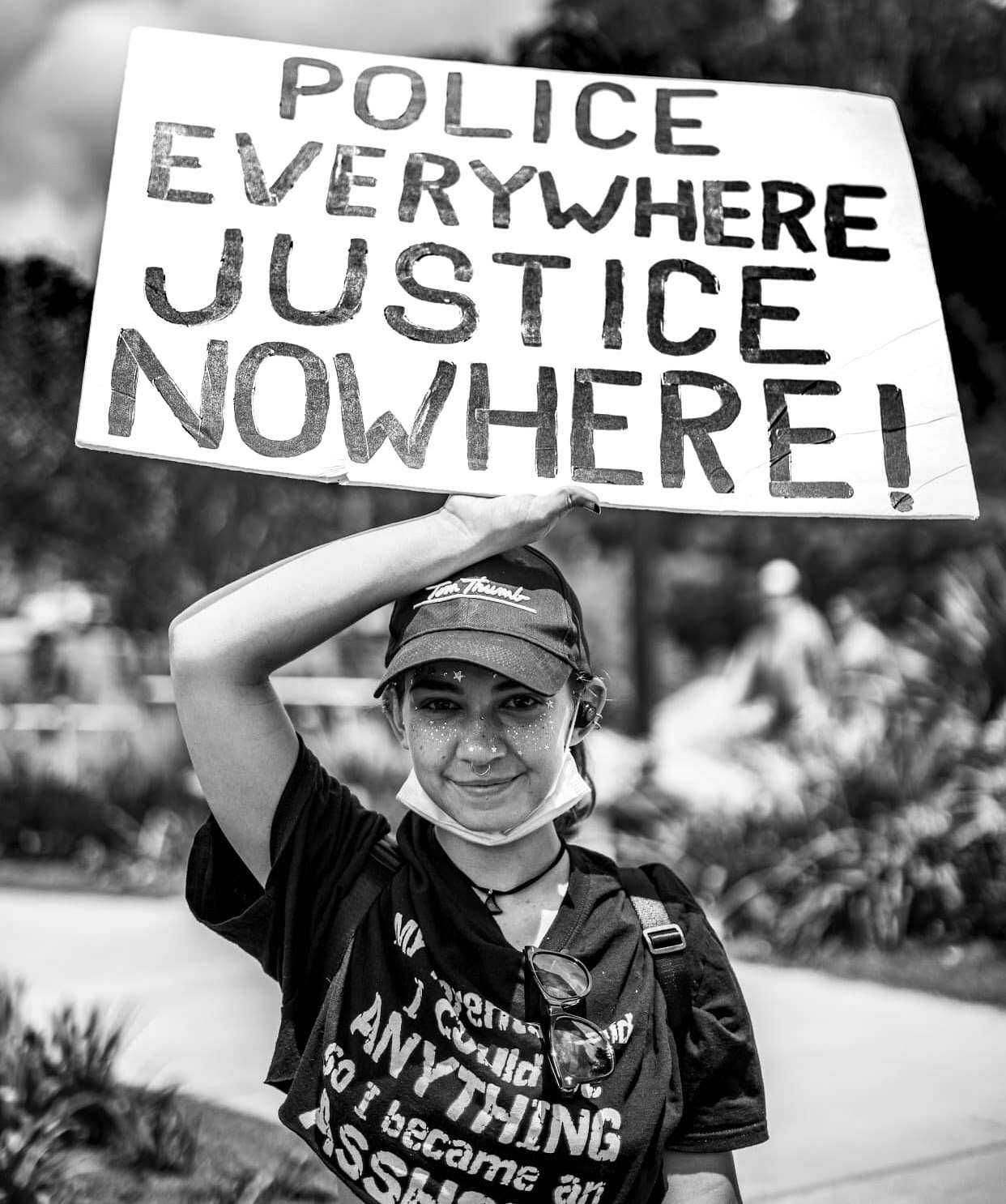  
Las Vegas, Nevada

 
Free Derry, Ireland
 
Dublin, Ireland

Kildare, Ireland
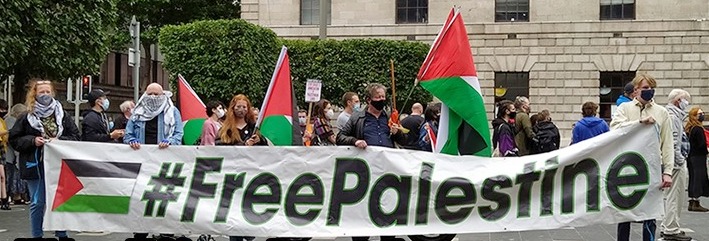
Ennis, Ireland
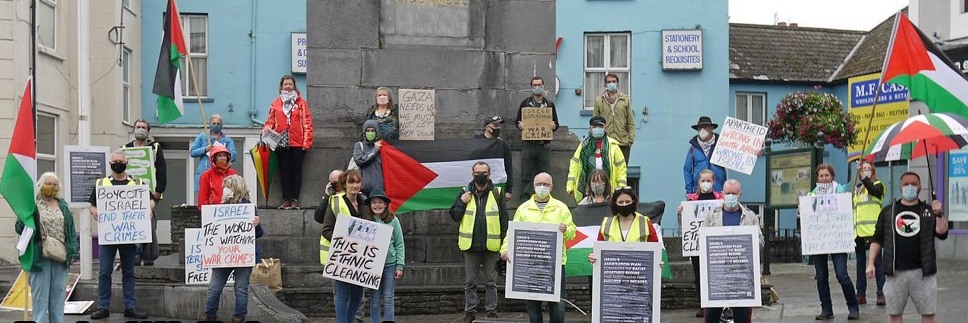
London, England
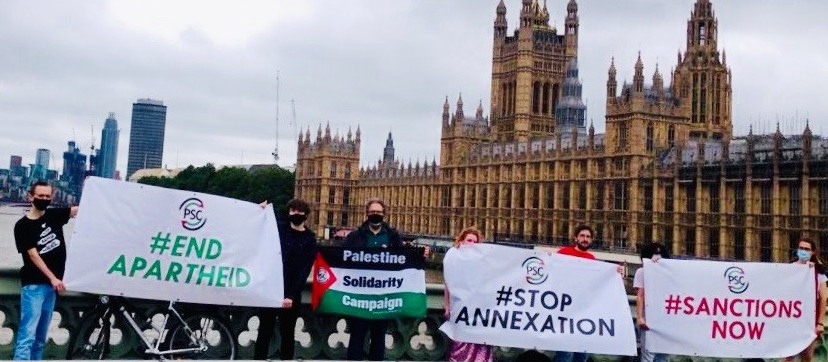
East London, England; Sheffield,
England
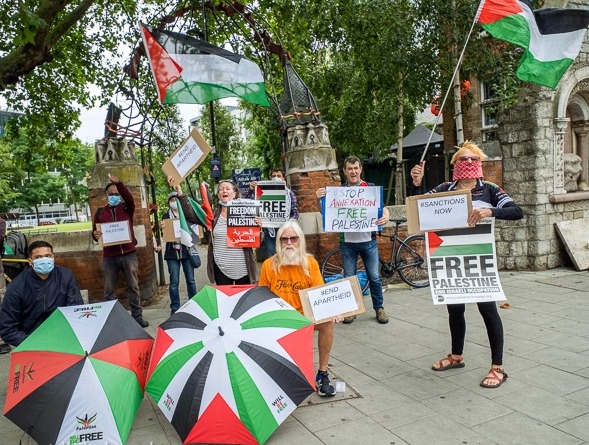 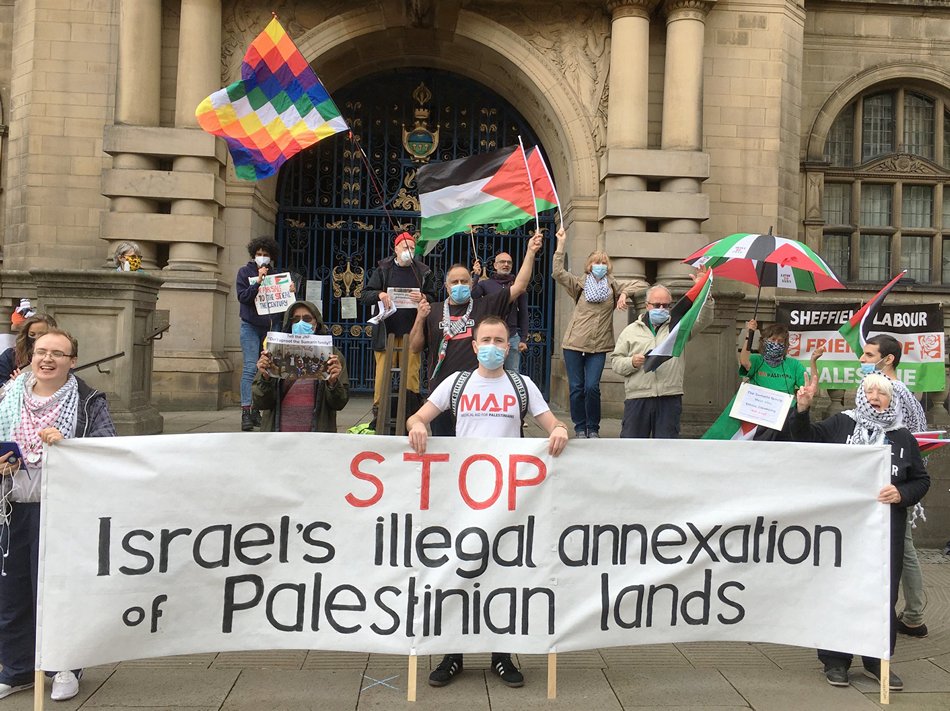
Manchester, England

Liverpool, England

Bristol, England


South Wales

Gothenburg, Sweden
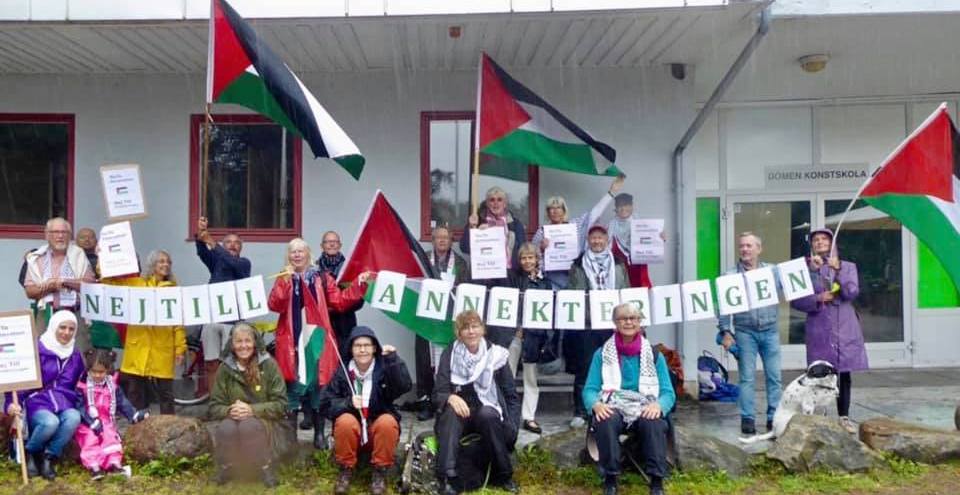
Copenhagen, Denmark
 

Vienna, Austria
 
Lisbon, Portugal

Montpellier, France
 
Gijon, Spain
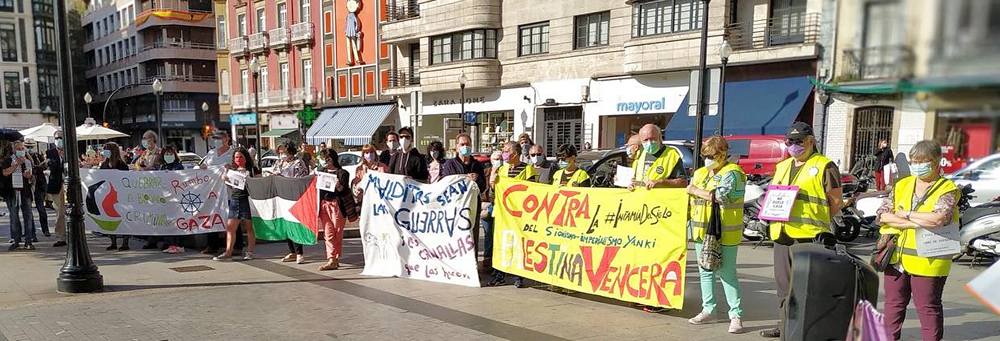

(To access articles
individually click on the black headline.)
PDF
PREVIOUS ISSUES | HOME
Website:
www.cpcml.ca Email: editor@cpcml.ca
|



 Samidoun reported
that nearly 300 people rallied in Toulouse, France, on July 1. For
almost two hours, the demonstrators chanted and shouted slogans: "Palestine vivra! Palestine
vaincra!" (Palestine will live, Palestine will win) and
"Boycott Israel!"
Samidoun reported
that nearly 300 people rallied in Toulouse, France, on July 1. For
almost two hours, the demonstrators chanted and shouted slogans: "Palestine vivra! Palestine
vaincra!" (Palestine will live, Palestine will win) and
"Boycott Israel!"
 One participant
enthusiastically wrote to TML Weekly that it
looked as if over 1,000 people joined in at one time or another over
the course of the three-hour protest. There was a constant presence of
200-250 people present braving the heat, with many passersby stopping
and joining in for shorter periods before going on their way.
One participant
enthusiastically wrote to TML Weekly that it
looked as if over 1,000 people joined in at one time or another over
the course of the three-hour protest. There was a constant presence of
200-250 people present braving the heat, with many passersby stopping
and joining in for shorter periods before going on their way.


















 Trudeau set the
stage for this disinformation in a press conference just prior to the
Finance Minister's presentation in Parliament. Referring to what has
now become a $343.2 billion federal deficit to be covered through
government borrowing from the private financial institutions of the
global oligarchy, Trudeau said, "We took on debt so Canadians wouldn't
have to." Clearly the Prime Minister thinks Canadians have no
intelligence; that they cannot see through his unfortunate obsession
with the word "we."
Trudeau set the
stage for this disinformation in a press conference just prior to the
Finance Minister's presentation in Parliament. Referring to what has
now become a $343.2 billion federal deficit to be covered through
government borrowing from the private financial institutions of the
global oligarchy, Trudeau said, "We took on debt so Canadians wouldn't
have to." Clearly the Prime Minister thinks Canadians have no
intelligence; that they cannot see through his unfortunate obsession
with the word "we."
 The U.S.-led
imperialist system of states has been organized to pay the rich. It
does everything to defend and sustain the privilege of ownership of
private enterprise and the stupendously wealthy oligarchs who own and
control the private global industrial and financial cartels.
The U.S.-led
imperialist system of states has been organized to pay the rich. It
does everything to defend and sustain the privilege of ownership of
private enterprise and the stupendously wealthy oligarchs who own and
control the private global industrial and financial cartels. Working people
should ponder a situation where such great amounts of
privately-controlled money are so readily available for governments to
borrow. How can the rich oligarchs be in possession of such enormous
wealth at a time of crisis when governments declare themselves broke?
The stupendous amount the rich have available to lend to governments
indicates how productive the working class is and how much the rich
expropriate and accumulate from what workers produce. The billions the
government will borrow from private sources to cover the $343 billion
deficit originate from the work-time of the Canadian working class but
end up under the control of a minority of immensely wealthy global
oligarchs.
Working people
should ponder a situation where such great amounts of
privately-controlled money are so readily available for governments to
borrow. How can the rich oligarchs be in possession of such enormous
wealth at a time of crisis when governments declare themselves broke?
The stupendous amount the rich have available to lend to governments
indicates how productive the working class is and how much the rich
expropriate and accumulate from what workers produce. The billions the
government will borrow from private sources to cover the $343 billion
deficit originate from the work-time of the Canadian working class but
end up under the control of a minority of immensely wealthy global
oligarchs. The captains of
industry, finance and commerce are not simply waiting for their
purchase of government bonds to be repaid with interest. They are
eagerly anticipating that the money they have loaned to governments
will soon come back to them in lucrative pay-the-rich schemes. The
government has already announced billions of dollars of guaranteed
infrastructure projects: contracts for military supplies to prepare for
war are a constant feature, and supplying the education and health care
sectors with computers, and pharmaceuticals such as a vaccine for
COVID-19 means guaranteed profits for the biggest companies.
The captains of
industry, finance and commerce are not simply waiting for their
purchase of government bonds to be repaid with interest. They are
eagerly anticipating that the money they have loaned to governments
will soon come back to them in lucrative pay-the-rich schemes. The
government has already announced billions of dollars of guaranteed
infrastructure projects: contracts for military supplies to prepare for
war are a constant feature, and supplying the education and health care
sectors with computers, and pharmaceuticals such as a vaccine for
COVID-19 means guaranteed profits for the biggest companies. This virtuous
circle of the imperialists explains how the federal government's
infrastructure plan called "Investing in Canada" pays the rich and
contributes to the ever greater concentration of wealth and power in
fewer hands. The federal government in 2019 committed $187 billion in
infrastructure funding over 12 years. The C.D. Howe Institute, an
imperialist think tank, insists the recent crisis should prompt the
government to spend even more and more quickly not only on new projects
but on maintaining and upgrading existing infrastructure.
This virtuous
circle of the imperialists explains how the federal government's
infrastructure plan called "Investing in Canada" pays the rich and
contributes to the ever greater concentration of wealth and power in
fewer hands. The federal government in 2019 committed $187 billion in
infrastructure funding over 12 years. The C.D. Howe Institute, an
imperialist think tank, insists the recent crisis should prompt the
government to spend even more and more quickly not only on new projects
but on maintaining and upgrading existing infrastructure.



 Because of huge
public support for these workers, both the Quebec and Canadian
governments want to be seen as recognizing their contribution during
the pandemic but thus far, have done nothing concrete to assist them.
Many continue to be threatened with deportation, as a representative of
the Committee of Guineans United for Status pointed out. And if members
of his community are deported, they face violence in their home country.
Because of huge
public support for these workers, both the Quebec and Canadian
governments want to be seen as recognizing their contribution during
the pandemic but thus far, have done nothing concrete to assist them.
Many continue to be threatened with deportation, as a representative of
the Committee of Guineans United for Status pointed out. And if members
of his community are deported, they face violence in their home country.










 According to an
expert report on the seven major derailments of oil-carrying trains in
Canada that have occurred since the Mégantic
derailment, which was presented in a CBC report on June 15, the
condition of the rails is responsible for the derailments. This is
because the railway safety regulations on which the maintenance
standards are based date back to 2012, that is, before the massive
transportation of oil on the rails. The regulations are written based
on the old practice of regular freight trains and have not been
adjusted to the new reality of massive oil transportation. So the rails
wear out faster with characteristic breakages due to the overweight
trains. So the Transportation Safety Board of Canada made that
observation and recommended that the railway safety regulations be
reviewed because they no longer correspond to reality. These
regulations govern the companies and define maintenance standards.
Journalists have proven that these seven major derailments since
Mégantic are due to the fact that maintenance protocols are
not up to date and that the trains are heavier and longer. The CMQR
boasted that the weight of its trains passing through
Mégantic had increased by 56 per cent.
According to an
expert report on the seven major derailments of oil-carrying trains in
Canada that have occurred since the Mégantic
derailment, which was presented in a CBC report on June 15, the
condition of the rails is responsible for the derailments. This is
because the railway safety regulations on which the maintenance
standards are based date back to 2012, that is, before the massive
transportation of oil on the rails. The regulations are written based
on the old practice of regular freight trains and have not been
adjusted to the new reality of massive oil transportation. So the rails
wear out faster with characteristic breakages due to the overweight
trains. So the Transportation Safety Board of Canada made that
observation and recommended that the railway safety regulations be
reviewed because they no longer correspond to reality. These
regulations govern the companies and define maintenance standards.
Journalists have proven that these seven major derailments since
Mégantic are due to the fact that maintenance protocols are
not up to date and that the trains are heavier and longer. The CMQR
boasted that the weight of its trains passing through
Mégantic had increased by 56 per cent. It should also be
added that the trains are still parked at the top of the hill. Since
there is no longer a rail yard in
downtown Mégantic, the company is shunting in
Nantes, at the same place where the death train was parked on July 6,
2013. It parks cars from the industrial park on the service track and
when the train arrives from the United States with the dangerous
material, they stop parallel to them on the main track, next to the
cars to be loaded. They apply only air brakes on the slope, no hand
brakes. And there they detach the four locomotives that will pick up
the cars on the other track, leaving the whole train alone, on simple
air brakes on the grade, from 45 minutes to one hour. That's how long
it took, when the firemen left Nantes, for the train to go down the
slope in 2013. These manoeuvres are carried out two to three times a
week in Mégantic. We are in the same scenario. Nothing has
really changed, except that the materials are 10 times more dangerous.
I have reported this twice to the City of Mégantic and
Transport Canada. We also see it in the video.
It should also be
added that the trains are still parked at the top of the hill. Since
there is no longer a rail yard in
downtown Mégantic, the company is shunting in
Nantes, at the same place where the death train was parked on July 6,
2013. It parks cars from the industrial park on the service track and
when the train arrives from the United States with the dangerous
material, they stop parallel to them on the main track, next to the
cars to be loaded. They apply only air brakes on the slope, no hand
brakes. And there they detach the four locomotives that will pick up
the cars on the other track, leaving the whole train alone, on simple
air brakes on the grade, from 45 minutes to one hour. That's how long
it took, when the firemen left Nantes, for the train to go down the
slope in 2013. These manoeuvres are carried out two to three times a
week in Mégantic. We are in the same scenario. Nothing has
really changed, except that the materials are 10 times more dangerous.
I have reported this twice to the City of Mégantic and
Transport Canada. We also see it in the video.

 The July 11 SQ
raid came after an ultimatum, in the form of a court order that the
mayor and municipal council of Oka had sought which supported the
expansion of the private golf course on stolen Indigenous land: the
Kanien'kehá:ka of Kanehsatà:ke had to bring down
their barricade by July 9 or else face the full force of the law.
The July 11 SQ
raid came after an ultimatum, in the form of a court order that the
mayor and municipal council of Oka had sought which supported the
expansion of the private golf course on stolen Indigenous land: the
Kanien'kehá:ka of Kanehsatà:ke had to bring down
their barricade by July 9 or else face the full force of the law.
























